Outboard vs. Inboard: Which Motor is Right for You?
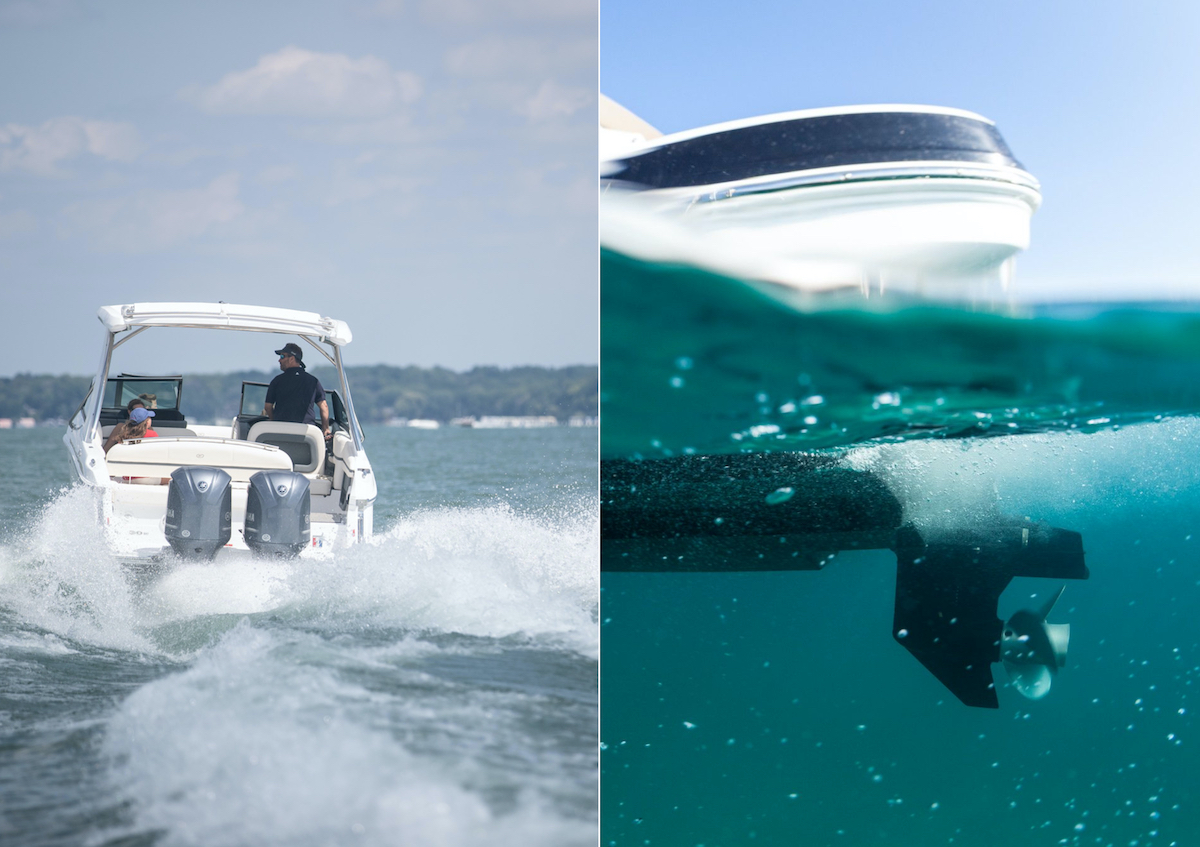
Many family boats, including bowriders , deck boats and cabin cruisers , are offered with a choice of outboard or inboard power. When both options are available, is there a better choice between the two? Let’s take a look at inboard vs. outboard boat motors , and dig deeper into the advantages and disadvantages of each type of power.
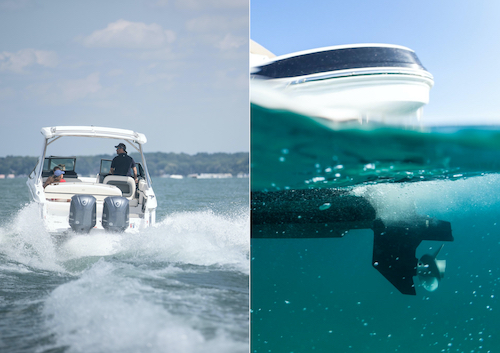
Explore All Boat Motor Types & Brands

What are the Key Differences Between Inboard and Outboard Motors?
Family boats with inboard power are almost always equipped with a sterndrive (sometimes called an inboard/outboard or I/O) powertrain, which combines an automotive-type engine mounted inside the boat with a steerable and trimable drive unit mounted on the stern (the back) of the boat. The exception would be for a dedicated watersports tow boat , which has an inboard engine turning a propeller under the boat, with steering control provided by a rudder.
Sterndrives are currently offered from 200 horsepower to 430 horsepower, but many compact runabouts on the pre-owned market may be powered by a 130-horsepower sterndrive that is no longer in production. An outboard motor is a dedicated marine engine that is attached directly to the stern of a boat.
Outboards are available from tiny 2-horsepower kickers to 600 horsepower, but for family boating the range is typically 90 to 300 horsepower. As outboard motors have become more powerful, they are gaining popularity on larger cabin cruiser and day boats that once were always equipped with inboard engines. These may be rigged with three or four outboards that combined make more power than the biggest pair of sterndrive engines available, resulting in performance that was once unimaginable.
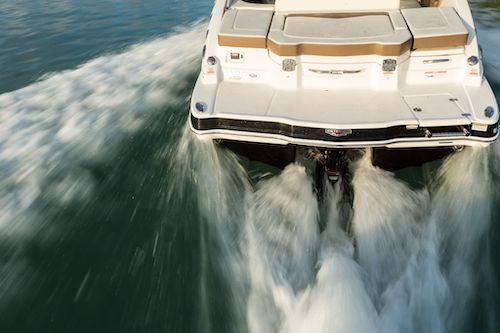
Initial Cost Comparison
It seems natural to make a cost comparison based on horsepower—a 250-horsepower outboard to a 250-horsepower sterndrive in the same boat—but it’s smarter to make that comparison based on performance.
In this example, a 200-horsepower outboard will usually match the performance of a 250-horsepower sterndrive, simply because the outboard weighs less, and because that weight is more efficiently positioned behind, rather than inside, the boat. This rule of thumb holds true as you move up and down the horsepower scale. However, even with less horsepower the outboard-powered boat will often cost a little more—2 to 4 percent—than a similar boat with a sterndrive.
Inboard vs. Outboard Maintenance Costs & Ownership
Because it will usually weigh less and be a more-efficient design, an outboard motor will typically deliver better fuel economy than a sterndrive. Both will require similar annual maintenance, except that in cold climates the cooling system of most sterndrive engines needs to be flushed with antifreeze solution, usually by a marine service center.
- An outboard is self-draining and many owners can accomplish their own off-season service.
- Sterndrives once had a reputation for being more prone to corrosion-related issues in salt water, but corrosion resistance is much improved on modern engines and outdrives, and many can be equipped with a closed cooling system that keeps most saltwater out of the engine.
- However, most sterndrives can not be tilted completely out of the water, while most outboards can clear the water when tilted all the way up. This is an advantage for the outboard if the boat is docked or moored full time in saltwater, as it prevents marine growth and corrosion from occurring on the drive.
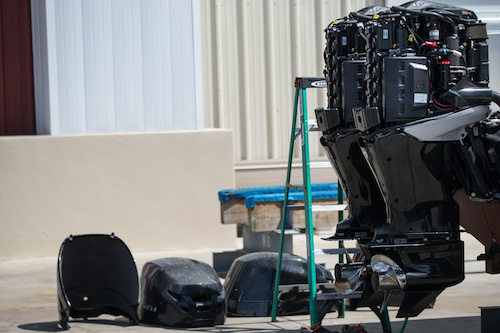
Serviceability
Because the entire engine is outside the boat, an outboard is easier to service than an inboard. With the boat on a trailer you can simply stand next to the outboard.
Servicing the inboard requires working under an engine hatch, often in pretty cramped confines. When an outboard is damaged or simply worn out, it is relatively easy to re-power the boat with a new outboard. Repowering an inboard boat is also an option, but a more-challenging project.
- Boat Motor Maintenance & Engine Care Guide
Additional Pros & Cons
An outboard has many advantages over a sterndrive:
- It’s lighter, faster, more efficient, and easier to service;
- Because the entire engine is located outside the boat, there’s more room in the boat for seating or gear storage;
- A new outboard is cleaner, quieter and more powerful and feature-laden than the motors offered just a few years ago, all reasons they have become more popular on more types of boat.
A sterndrive does have some advantages, however:
- The drive unit is low on the transom, which permits a full-width boarding or swim platform that’s not cluttered by an outboard motor. This can really improve the lounging experience, and many people find this uncluttered look much more attractive.
- The sterndrive engine may also be covered by a padded sun lounge, another feature many owners appreciate.
- When equipped with a drive with forward-facing propellers ( Volvo Penta Forward Drive or MerCruiser Bravo Four ), the boat can be used for wakesurfing , an activity that’s not safe—or even legal on most waters—behind a boat with a traditional sterndrive or an outboard because of the proximity of the spinning propeller to the surfer. For many boating families, the ability to wake surf is reason alone to select an inboard with forward-facing props.
Read Next: Comparing Jet Boats vs. Sterndrive (Prop) Boats
You May Also Like:
- Choosing the Right Fuel & Oil for Your Marine Engine
- How to Make Your Boat Go Faster
- Boat Repair: Choosing a Marine Mechanic
- Find the Right Boat for Your Lifestyle
Join Our Newsletter!
Get community news, buying bargains, and how-to guides at your fingertips.

Service Locator
- Angler Endorsement
- Boat Towing Coverage
- Mechanical Breakdown
- Insurance Requirements in Mexico
- Agreed Hull Value
- Actual Cash Value
- Liability Only
- Insurance Payment Options
- Claims Information
- Towing Service Agreement
- Membership Plans
- Boat Show Tickets
- BoatUS Boats For Sale
- Membership Payment Options
- Consumer Affairs
- Boat Documentation Requirements
- Installation Instructions
- Shipping & Handling Information
- Contact Boat Lettering
- End User Agreement
- Frequently Asked Questions
- Vessel Documentation
- BoatUS Foundation
- Government Affairs
- Powercruisers
- Buying & Selling Advice
- Maintenance
- Tow Vehicles
- Make & Create
- Makeovers & Refitting
- Accessories
- Electronics
- Skills, Tips, Tools
- Spring Preparation
- Winterization
- Boaters’ Rights
- Environment & Clean Water
- Boat Safety
- Navigational Hazards
- Personal Safety
- Batteries & Onboard Power
- Motors, Engines, Propulsion
- Books & Movies
- Communication & Etiquette
- Contests & Sweepstakes
- Colleges & Tech Schools
- Food, Drink, Entertainment
- New To Boating
- Travel & Destinations
- Watersports
- Anchors & Anchoring
- Boat Handling
Types of Powerboats and Their Uses
Advertisement
What Is An Outboard Runabout?
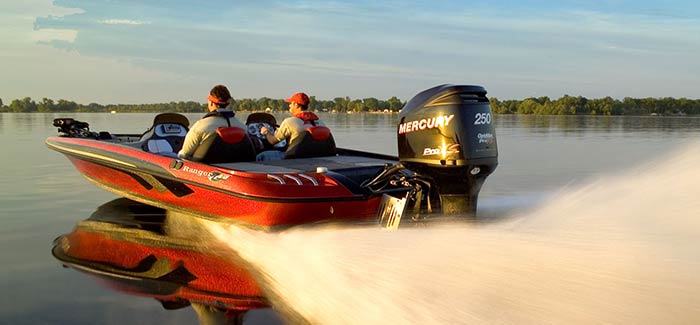
Bass boats are generally 14' to 23', and typically used for freshwater fishing. They have low freeboard and a V hull. They are specialized for bass fishing on inland lakes and rivers. Due to the special gear, high horsepower outboards and trolling motors they are a relatively high price point.
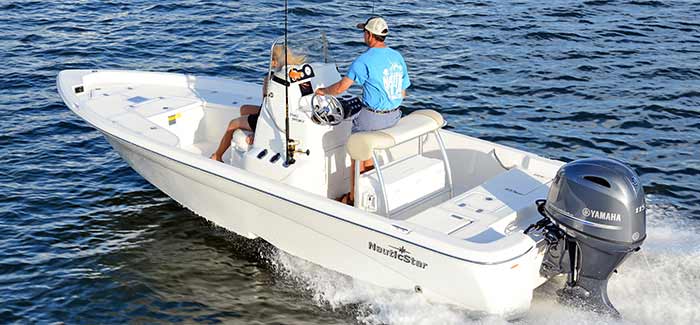
Bay boats have a low profile. They are designed for use in shallow waters of large shallow bays, estuaries or near shore. Bay boats are 18'–24' in length and are fiberglass because they are used in salt or brackish waters. They have more freeboard than a flats boat.
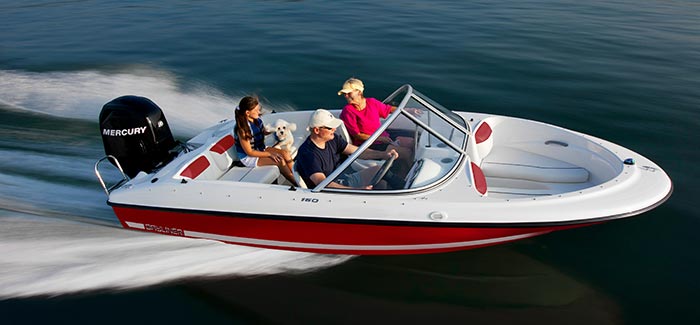
A bowrider has an open bow area designed for extra seats forward of the helm. Bowriders are usually 17'–30'. They are powered by either stern drive or outboard engines. Considered a family boat and can be used for fishing and water sports. A good choice for those new to boating.
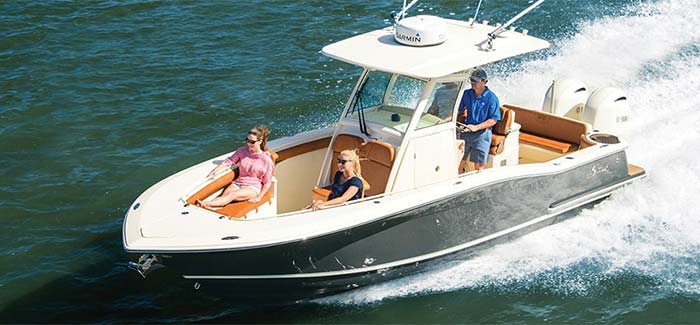
Center Console
Center console boats are from 13'–45'. They are so-named because their helm is on a console in the center of the boat. Like walkarounds, the open hull helps anglers walk from bow to stern without having to navigate around the console. Most use outboard motors for propulsion and the larger size boats are suited for offshore fishing.
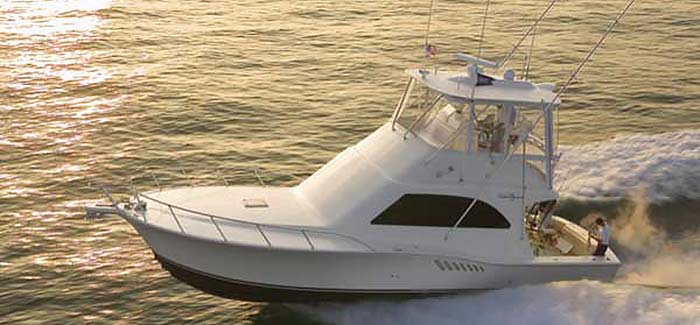
Convertible Fishing Boat
Convertibles are 35 foot and greater boats suited for offshore fishing and cruising. They have large cabins, galleys and berths and are perfect for pleasure cruises and offshore fishing. The flybridge with elevated helm helps to spot flotsam or fish. They have a large fishing deck aft.
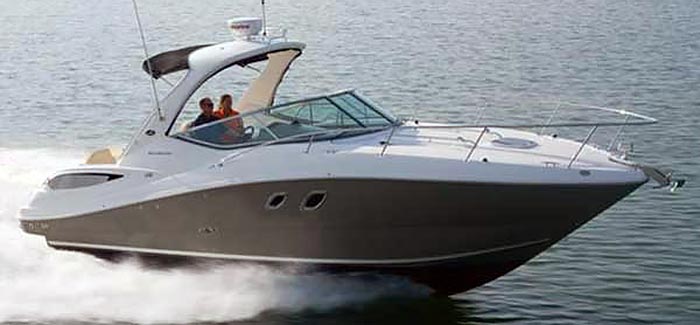
Cruisers are from 21'–45' in length and have a cabin in the bow of the boat. Cruiser cabins are designed for an overnight stay and are typically large enough for a small galley, several berths and an enclosed head.
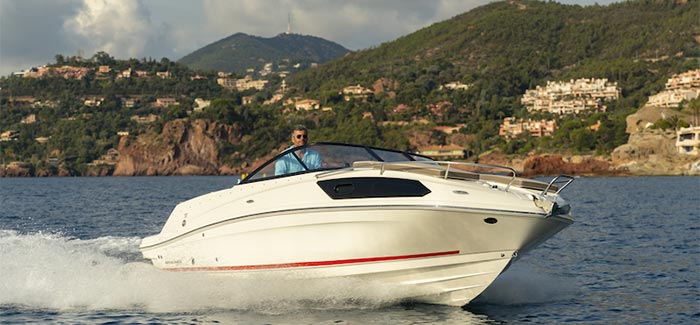
Cuddy Cabin
Cuddy cabin boats have a small cabin for storage or a small seating area. They may accommodate a berth and or head. They are usually about 22–30 feet in length.
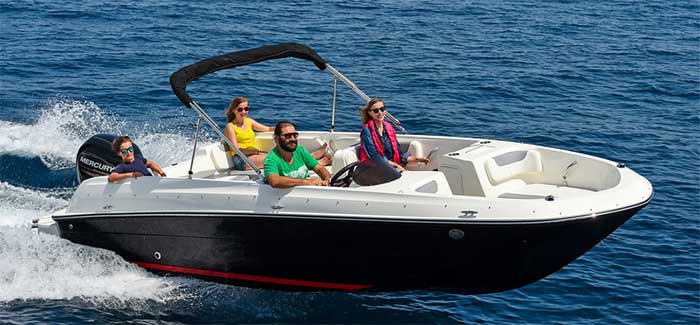
Deck boats have a wide beam and feature a V-shaped hull which offers more performance than a pontoon boat. Featuring an open deck with plenty of seating for parties or family. Used for swimming and water sports. They are outboard or stern drive powered and can be aluminum or fiberglass. These boat are about 25–35 feet long.
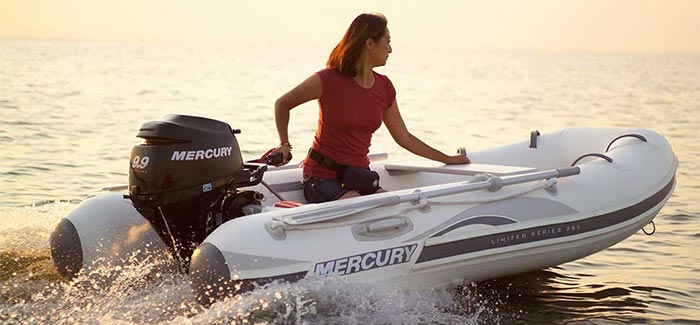
A dinghy is a small boat, usually 7–12 feet in length. They are usually powered by oars, small outboards, or sails. Often carried or towed by a larger boat for going ashore. Low cost and an excellent choice for those new to boating.
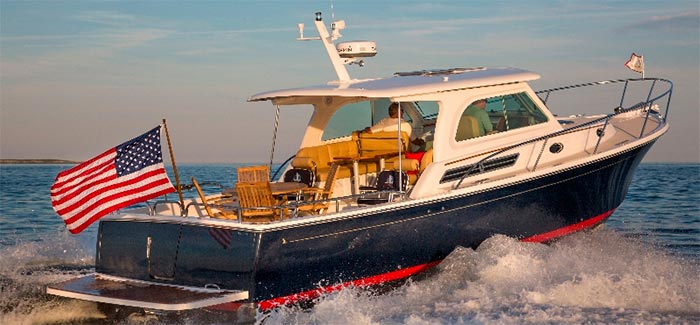
Downeast Cruiser
These boats are native to coastal New England. Also called lobster boats, they are built for offshore cruising and fishing. They have a cabin with berths and a head and dining area.
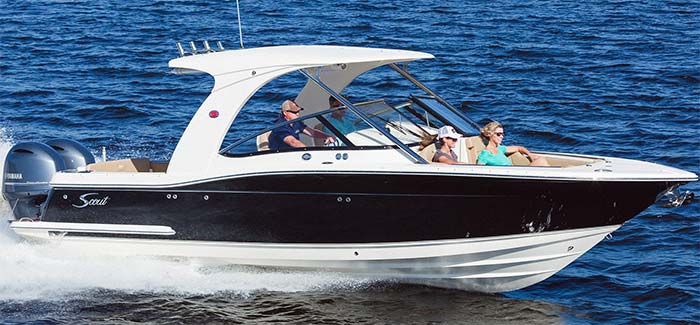
Dual Console
Dual Console boats have two dashboards and windshieldswith space to walk between them for allowing access to the bow area for seating and/or fishing. Lengths run 16–30 feet.
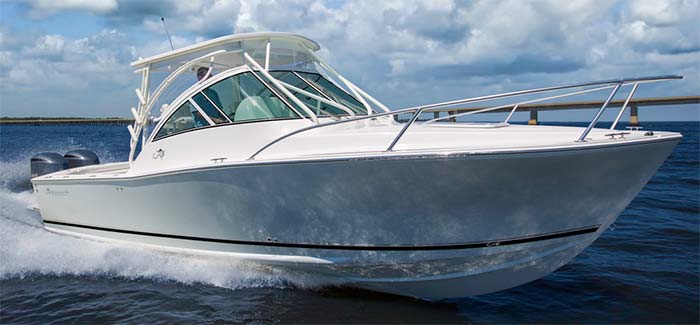
Express Fisherman
The Express Fisherman is designed for high speeds to get to offshore fishing spots in a hurry. They are rigged for offshore fishing. They have large open cockpits and fish fighting areas aft. They usually have limited cruising accommodations but can provide overnight shelter.
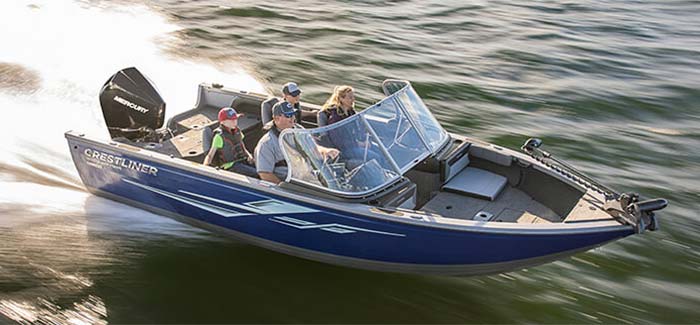
Fish 'n Ski Boat
Fish 'n Ski boats are used for fishing or skiing. These are family boats. They have accessories for each application. They feature comfortable seating and offer livewells and tie downs for rods and have removable, elevated tow bars and ski lockers. They are usually 16–24 feet in length.
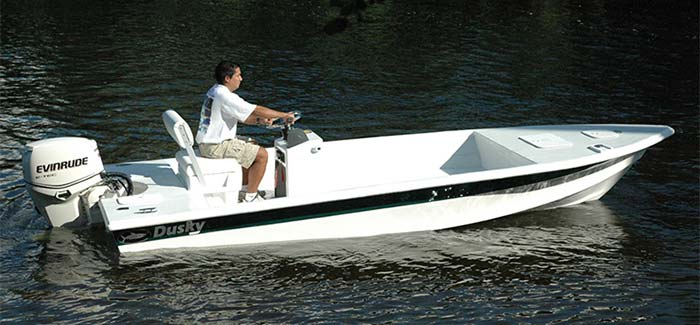
Flats Boats range from 14 feet to 18 feet and are specifically designed to navigate shallow waters needing extremely shallow drafts. A push pole is used to navigate the shallow water.
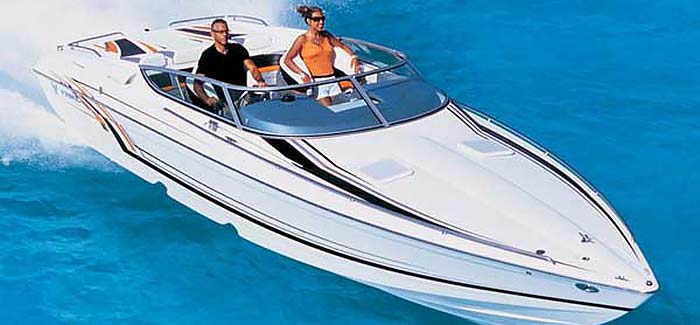
High Performance Boat
Performance powerboats are built for speed, featuring narrow beam, steep deadrise, and high power to weight ratios. They have Spartan cabins. Cockpits seat 2–6 passengers. Powered by high horsepower outboards, stern drives or surface drives, these boats are carefully designed to be fast, light and strong, ideal for racing or fast cruising. They range from 25–60 feet in length.
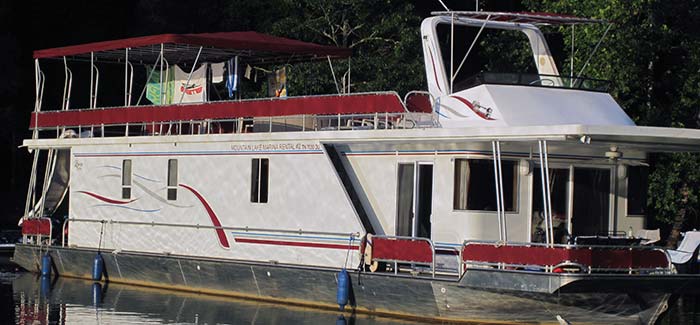
As the name implies houseboats are floating houses. They are either outboard or inboard propelled and range from 25 to 150 feet in length. Just like a house they have full kitchens, bedrooms and living and dining areas. They are the ultimate family boat. They are generally found on quieter bodies of water since they have low freeboards and are built on a barge-like hull.
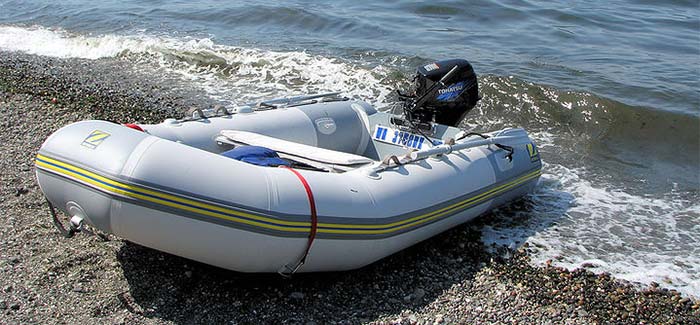
Inflatable Boat
Usually 6'–14' in length and have inflatable tubes for their sides. The floor is flexible or made rigid using plywood or aluminum floorboards depending on the size. Outboard motors can be used on the rigid transom. They deflate and are easy to transport or store. Used as dinghies on larger boats. A good choice for those new to boating.
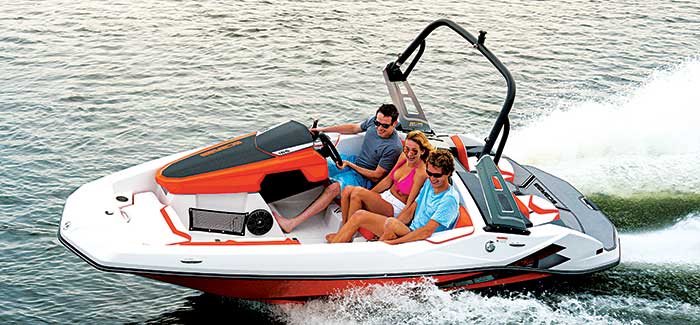
Jet Boats have single or multiple jet drives instead of a propeller for propulsion. They are very maneuverable. These smaller boats (14–24 feet) are generally used for water sports and getting into shallow waters.
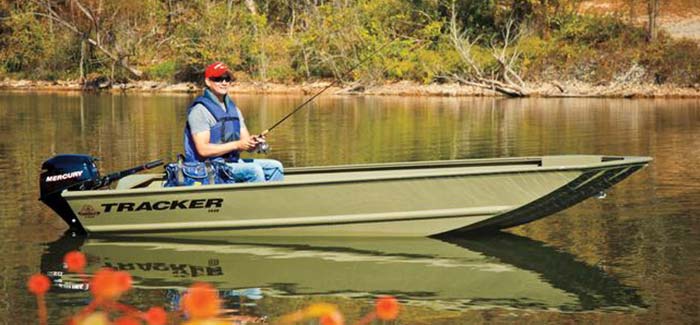
Jon boats are small utility craft primarily used for boating in shallow water. They range from 10 to 18 feet in length. They can be made of aluminum or fiberglass. They are inexpensive and a good choice for the novice boater.
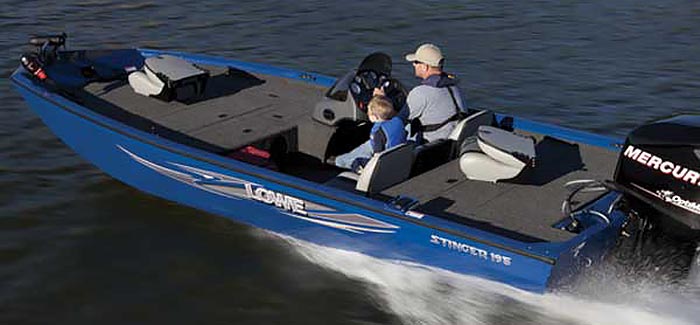
Multi-species Boat
Multi-species boats are 17–23 feet in length. They are made of fiberglass or aluminum. They are designed to travel in rougher water than bass boats. As the name implies, these boats are made for fishing a variety of different fish in all types of water.
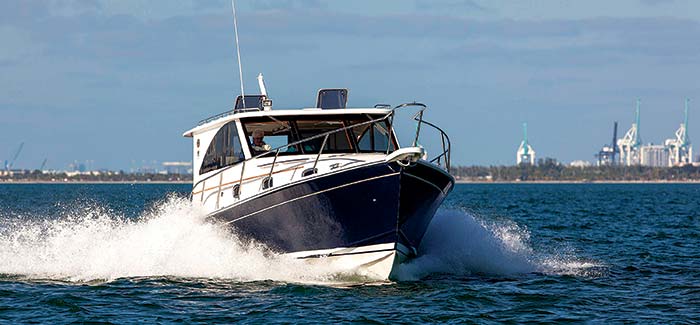
Pilothouse Boat
Featuring a fully enclosed pilot house, these boats are built to ride rougher seas while keeping helmsman high and dry. They are powered by outboards, stern drives or inboards. They are popular for cruising and many types of fishing. They usually have a berth and a head. They are usually 20–35 feet in length.
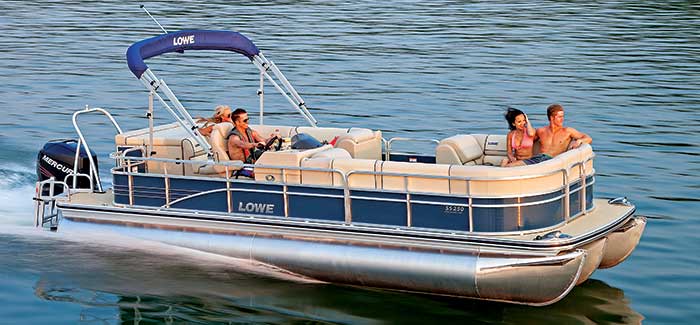
Pontoon Boat
Pontoon boats have 2 or 3 aluminum tubes that support a broad platform. They have shallow drafts and are very stable. They are usually found on inland lakes and rivers and other small bodies of water. Used for cruising, fishing and water sports. Powered by an outboard or stern-drive. Lengths from 15–30 feet.
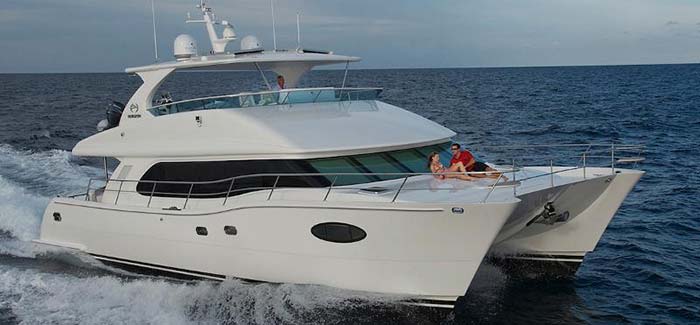
Power Catamaran
These dual-hull boats are generally used for offshore fishing. They are more rugged, provide a more stable ride, faster speeds and better fuel economy than mono-hulls. They are 25–40 feet in length.
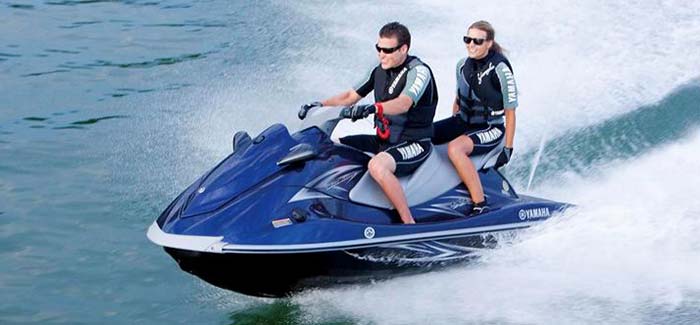
PWC (Personal Watercraft)
Entry level boats that are fun to drive and economical to buy. They come in lengths from 9–14 feet. They are usually built for 1 or 2 people but larger, more powerful models can seat up to 4. They are powered by jet drive.
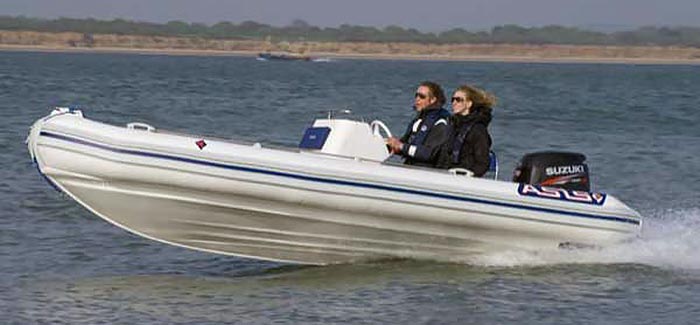
Rigid Inflatable
RIBs (rigid inflatable boat)s have a fiberglass or aluminum hull attached to inflatable outer tubes. Outboard motors are used on the transom for power. RIBs are usually faster, larger, and can carry more weight than flexible floored inflatables. They also come in larger sizes.
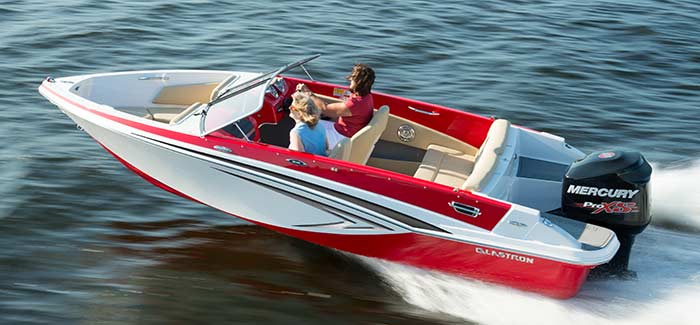
Many boats are called runabouts. Generally a runabout is defined as a small powerboat somewhere in the 14–24 foot range. They are usually powered by an outboard or stern-drive engine. They are a multipurpose boat suitable for water sports, cruising and fishing.
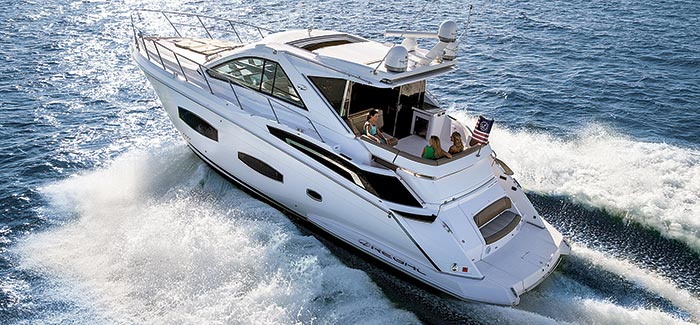
Sedan Bridge Boat
Intended for extended cruising with accommodations down below to suit long stays on the water. They range from about 35–65 feet. The bridge positions the helmsman high above the water allowing for great visibility.
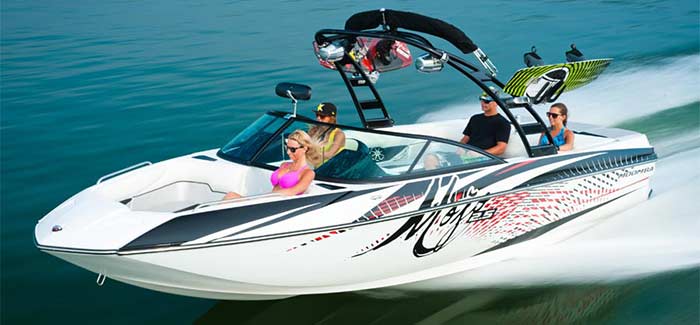
Ski and Wakeboard Boat
These boats are designed specifically for water sports. They can be ballasted for producing higher wakes for trick skiing and waterboarding. They are also great for pulling inflatable tubes.
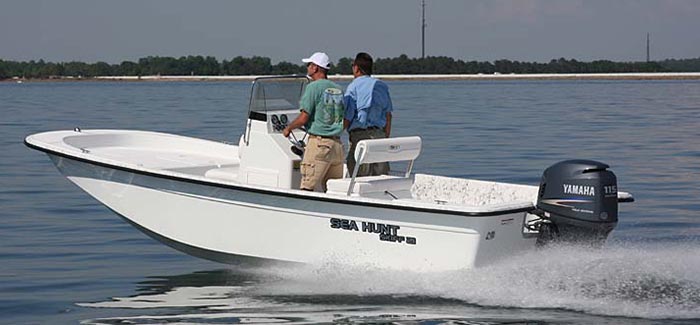
The skiff is similar to a Jon boat. They are another entry level boat. They are especially good for boating in shallow water. The can have flat or cathedral shaped hulls. Many have a console to steer from.
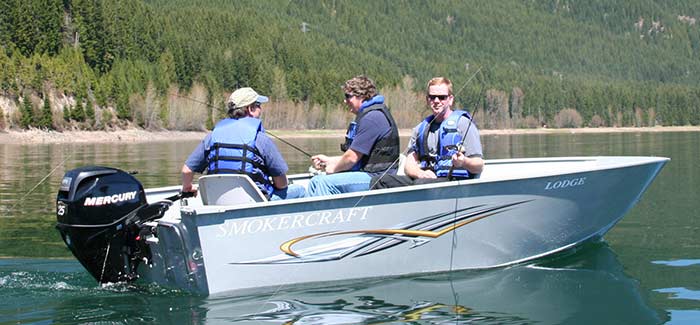
Utility Boat
Utility boats are made for tough use. Generally made of aluminum with outboard power and range from 12–20 feet. Used for fishing or as workboats. Relatively low cost to maintain and a good choice for the novice boater.
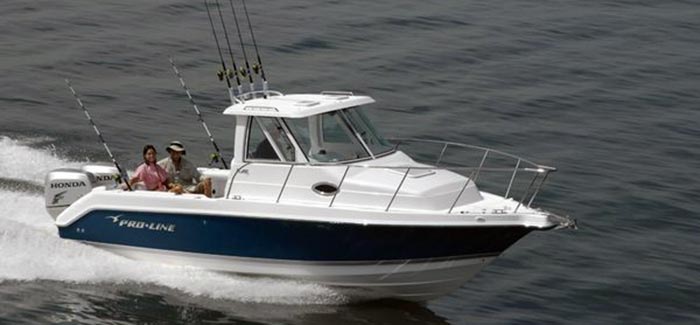
Walkarounds
Walkarounds allow an angler to walk around the cabin. They are generally 20–30 feet in length. They are usually found on larger bodies of water and can be powered by an outboard, Inboard/outboard or inboard engine.
Related Articles
The truth about ceramic coatings for boats.
Our editor investigates the marketing claims of consumer-grade ceramic coatings.
Fine-Tune Your Side Scan Fishfinder
Take your side-scanning fishfinder off auto mode, and you’ll be spotting your prey from afar in no time
DIY Boat Foam Decking
Closed-cell foam flooring helps make boating more comfortable. Here’s how to install it on your vessel
Click to explore related articles
BoatUS Editors
Contributor, BoatUS Magazine
Award-winning BoatUS Magazine is the official publication of Boat Owners Association of The United States. The magazine provides boating skills, DIY maintenance, safety, news and more from top experts.
BoatUS Magazine Is A Benefit Of BoatUS Membership
Membership Benefits Include:
Subscription to the print version of BoatUS Magazine
4% back on purchases from West Marine stores or online at WestMarine.com
Discounts on fuel, transient slips, repairs and more at over 1,200 businesses
Deals on cruises, charters, car rentals, hotel stays and more…
All for only $25/year!
We use cookies to enhance your visit to our website and to improve your experience. By continuing to use our website, you’re agreeing to our cookie policy.

Chieftain Training
RYA & STCW Courses – Sail, Power, Super-Yacht & Workboat
The difference between Powerboat and Motorboat Training
In the RYA training world we often talk about Powerboat Training ( Level 1 , Level 2 , Intermediate , Tender Operator and Advanced ) and Motor Cruising Course s ( Helmsman’s , Day Skipper Power , Coastal Skipper Power and Yachtmaster Power ).
What is the difference between a Powerboat and a Motorboat?
We are often asked this question. There is no exact definition, so we have produced some guidance;
| Feature | Powerboat | Motorboat |
|---|---|---|
| Onboard sleeping accommodation | Not usually as a powerboat is usually an open boat. | Yes, there will be a sleeping facilities on board such that a couple or perhaps even a small family could live aboard for several days, rather akin to being in a caravan. |
| Chart-table on board | Not usually. | Yes there will be somewhere where the skipper can consult navigational publications undercover. On a small motorboat this may be the saloon table. |
| Engine(s) | Normally outboard petrol engine(s) but can be inboard, petrol or diesel. Can be single or twin. | Usually (but not always) inboard diesel, shaft or stern drive. Can be single or twin, may also have a bow and/or stern thruster. |
| Heads (toilet) | Not normally. | Yes there will usually be a “heads” on board |
| Boat length | Typically 3.5m – 10m but can be bigger | Typically 7.5m – 24m. |
| RIB or Hard Boat | Either. | Usually a hard boat typically GRP, but can be timber, steel or aluminium). |
| Galley | Not usually, | Yes there will be somewhere where you can store food and prepare basic meals, this will usually include a kettle, a fridge, hob(s) and a sink. |

Powerboat or Motorboat?
There are of course some boats that sit on the cusp between a powerboat and a motorboat, here are a couple of examples.

At first glance the Axopar has some of the features common to powerboats, it looks like a large powerboat. It is 8.5m and powered by petrol outboard engines. However if we look closer we see it has cabin space, can sleep two people, has a heads (toilet), a nav area and can be used as a live aboard boat for a few days. On balance we would consider this more of a motorboat. If asked to deliver own boat tuition we would discuss what the owner wants to do with the boat but would be more likley to recommend the Helmsman’s and Day Skipper Power courses for the owner.
Bayliner VR5
This Bayliner has a small forward cabin with a berth which will sleep two, however it does not have a galley, it is an open boat and while it has some traits of a motor boat we consider it a powerboat and suitable for the RYA Powerboat Level 2 .
Share this:

Sailboat vs Powerboat - Which is Right for You?

Last Updated by
Daniel Wade
June 15, 2022
Sailboats and powerboats both have unique advantages and disadvantages. You have to weigh the pros and cons of each to know which boat is right for you.
Sailboats require a more hands-on approach, which many people prefer. Yet, powerboats have less maintenance and more speed. Which kind of boat you choose depends entirely on what kind of experience you want to have.
Powerboats are easier to operate, and they require a little experience. But, they are costly to keep running and you’re reliant on how much fuel you brought on board.
On the other hand, sailboats require training and experience. But, sailing is the purer boating experience, and many people prefer it because it offers them the freedom to travel anywhere in the world with only the wind.
Table of contents
Should You Get a Powerboat?
Powerboats are fast, fun, and spacious. For people who just want to get out on the water, without much setup, motorboats provide that easy access.
Depending on the boat, there are tons of family activities to do, such as tubing, waterskiing, wakeboarding, or fishing. Or, you can just enjoy a cruise around the waterways.
Powerboat Pros
Powerboats typically have more deck space because there isn’t as much hardware taking up space as in a sailboat. So, you can take out more people at a time, which is a pro for people with big families or who plan on taking many people out with them each time.
Often, the galley and cabin area has more space in a motorboat as well. People who plan on taking long off-shore fishing trips prefer motorboats because of the deck space for gear and people. Also, motorboats don’t have the same deep hull as a sailboat, so you can get into shallower waters if necessary.
If you’re new to boating, a powerboat might appeal to you more than a sailboat because there isn’t as much training involved in learning how to operate it. Sailboats take months (sometimes years) of experience to get confident with. With a motorboat, all you need is a GPS and a vessel license.
Also, to operate a motorboat, you’re only reliant on the sun shining. You don’t have to wait for wind conditions to be perfect. You can just get up and go whenever you feel like it. Unlike with sailing, where you are subject to changes in wind and tides.
Powerboat Cons
Even though powerboats are easier to operate and give you more space, they are more expensive to operate. You’re reliant on the engine to move, and you’ll likely use a lot of fuel each time you go out, which can quickly add up. Also, it’s less environmentally friendly than a sailboat, which uses minimal amounts of fuel.
The engines on powerboats are more expensive too. If for some reason you have to replace Or repair the engine on your boat, you can expect to pay a pretty penny. For that reason, it’s important to do regular check-ups and maintenance on your engine to keep it running smoothly.
The engine itself is also loud and smelly, which some people might say retracts from the experience of being out on the water. For people who get seasick especially, that smell doesn’t help.
Basically, with a powerboat, expect to pay more and have an experience that’s focused more on the water activity, rather than the joy of being on the water.
Should You Buy a Sailboat?
Sailing is one of the oldest methods of transportation, and that classic romantic feeling remains. With sailing, you have to pay attention to wind conditions, before you go out and as you’re on the water.
Sailboat Pros
Many people prefer sailing because it forces you to be in tune with the elements and the boat itself. Sailing is a very hands-on activity that requires training and practice to do effortlessly.
Because more effort goes into sailing, most people find it to be a rewarding experience that rejuvenates and refreshes the senses and the mind. You could compare operating a sailboat to doing yoga. All the pieces have to flow together, including the people on board.
Even small sailboats have trolling motors onboard. But, most sailors try to use the motor as little as possible and rely solely on the wind and tides. Not having a large engine saves you money on fuel and maintenance costs.
Sailing is much better for the environment than powerboats are. Sailing doesn't do any damage to the environment, as long as you stay off reefs and don’t allow trash to fall into the water. Motor usage is minimal, so you don’t contribute to the world’s fuel consumption as much. Many sailors pride themselves on being able to sail their boat without using the motor at all, even when it comes to docking.
Also, since sailboats rely on the wind, you can travel anywhere in the world if you want. There are countless accounts of people crossing oceans with only the wind in their sails.
Or, if sailing across the Atlantic isn’t for you, many people enjoy island hopping in the Caribbean for months at a time. If that appeals to you, you might be a sailor.
Unlike with a motorboat, you can go virtually anywhere on a sailboat with a bit of weather planning and manpower, no fuel necessary.
Sailing is a more satisfying experience and a quieter one as well. Since wind powers a sailboat, there’s no engine noise or smell to hinder your experience.
Some might say sailboats are for those people who are more adventurous at heart.
Sailboat Cons
Even though some people enjoy the hands-on aspect of sailing, it does require training. It’s dangerous to operate a sailboat on open water without proper knowledge of its workings.
Sailboats have a lot of moving parts and hardware. Many people grow up sailing and get their experience that way. But, if you aren’t someone who grew up sailing, you should consider a sailing class or even asking an experienced sailor to take you out and teach you what they know.
If you’re someone who doesn’t want to take the time to learn how to sail , it might not be the right boat for you.
Then, there’s the fact that you’re reliant on the right conditions for sailing. If there’s no wind or too much wind, your sailing experience won’t be as enjoyable or even possible. If you live somewhere that doesn’t have regularly good sailing conditions, that might prove to be a major con for you.
Or, if you don’t have a schedule that allows you to go sailing whenever the conditions are right (which could be in the middle of the week), you might not get as much sailing time out of your sailboat as you’d like.
There is no quick outing on a sailboat. It requires planning with the weather and tides, setting up the rigging and sails, and being at the mercy of the wind. So, if you don’t want your outing to take up most of the day, sailing might not be for you.
Because sailboats have deeper hulls, you have to be careful of shallow areas. It is possible to get stuck with a sailboat.
Also, many people choose to keep their sailboat in a slip at a marina because anything over 20’ is more difficult to transport and store. With a deck slip, you can keep the mast up and the rigging ready to go, so there’s less set up a time when you do want to go out.
So, if you’re in the market for a sailboat, make sure to check the cost of local dock slips as well and decide if that’s in your budget.
Because of the sails, mast, and rigging, you have less deck space with a sailboat. To get the deck space you desire, you’ll likely have to counter with a larger sailboat.
Finally, sailing is more of a commitment than a powerboat, but it’s a more rewarding experience that boating purists deem worth it.
Sailboat vs Powerboat: Which is Right for You?
There’s a lot to consider when it comes to deciding on a sailboat or a powerboat. Ultimately, it comes down to what kind of boating experience you’re looking for, and how much time you’re willing to commit to it.
Motorboats are a hobby, while sailboats are more of a lifestyle.
If you want to get out on the water without much fuss on choice weekends with your friends and family, a powerboat will get you out there. But, expect to pay high fuel prices and sacrifice some of the experience of being on the water.
On the other hand, if you’re looking for a way to get closer to nature, yourself, and possibly explore the world, a sailboat is the vessel for you. A sailboat requires more training to operate, more time to plan trips, and often you get fewer amenities with it.
Despite that, sailing is a purer boating experience that forces you to focus on the task at hand and the elements around you. If you plan to sail with your family or friends, it’ll be a bonding experience for everyone involved.
Related Articles
I've personally had thousands of questions about sailing and sailboats over the years. As I learn and experience sailing, and the community, I share the answers that work and make sense to me, here on Life of Sailing.
by this author
Most Recent

What Does "Sailing By The Lee" Mean?
October 3, 2023

The Best Sailing Schools And Programs: Reviews & Ratings
September 26, 2023
Important Legal Info
Lifeofsailing.com is a participant in the Amazon Services LLC Associates Program, an affiliate advertising program designed to provide a means for sites to earn advertising fees by advertising and linking to Amazon. This site also participates in other affiliate programs and is compensated for referring traffic and business to these companies.
Similar Posts

How To Choose The Right Sailing Instructor
August 16, 2023

Everything You Can Pull Behind A Boat
May 25, 2023

Cost To Sail Around The World
May 16, 2023
Popular Posts

Best Liveaboard Catamaran Sailboats
December 28, 2023

Can a Novice Sail Around the World?
Elizabeth O'Malley

4 Best Electric Outboard Motors

How Long Did It Take The Vikings To Sail To England?

10 Best Sailboat Brands (And Why)
December 20, 2023

7 Best Places To Liveaboard A Sailboat
Get the best sailing content.
Top Rated Posts
Lifeofsailing.com is a participant in the Amazon Services LLC Associates Program, an affiliate advertising program designed to provide a means for sites to earn advertising fees by advertising and linking to Amazon. This site also participates in other affiliate programs and is compensated for referring traffic and business to these companies. (866) 342-SAIL
© 2024 Life of Sailing Email: [email protected] Address: 11816 Inwood Rd #3024 Dallas, TX 75244 Disclaimer Privacy Policy

The Ultimate Guide to Choosing a Powerboat vs. a Sailboat
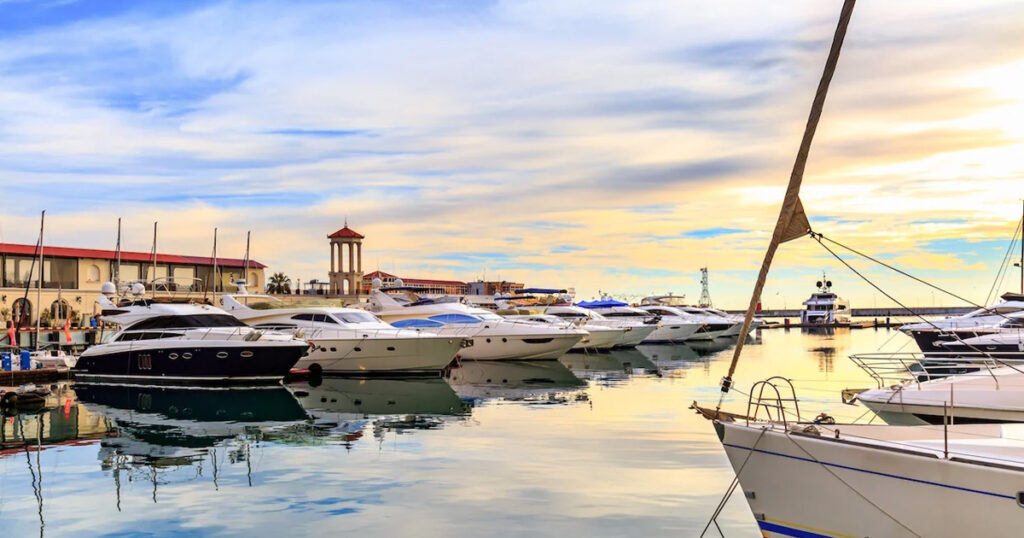
The decision between owning a sailboat vs. owning a powerboat can be a tough choice. The marina costs for both will be the same (depending on their size), and they both will have maintenance expenses related to their motors and other equipment. The real differences lie in how you intend to use it and what kind of experience you hope to have on the water.
{{cta(‘449d910e-2dcc-4c3d-9c13-b0c46eef3d38′,’justifycenter’)}}
If you want to fish and relax on the water, then the powerboat is the right choice for you. If you feel a sense of pride in navigating the water and weather with your own bare hands, then a sailboat will be more your style.
We’ve put together a list of pros and cons in owning and operating a powerboat vs. a sailboat to help you make your decision between the two lifestyles.
A powerboat is an ultimate Bay and ocean boat and is great transport for bays or short fishing trips into the wide-open water. Whenever you get the urge, you can hop in, turn the key, and go wherever your heart desires.
- Low Clearance. If you have bridges between you and many of your planned destinations, you’ll want to get a powerboat. No need to worry about mast height preventing you from taking a trip.
{{cta(‘3a5967fc-6bee-452d-90a9-20e4f06fa41a’)}}
- Motor Sound. If you don’t like the constant noise of a powerful engine, then the loud motor on the powerboat will be a con for you.
A sailboat is the perfect boat for people who want to connect to the water and weather on a primal level and understand how to navigate the world on their own power. If you want to live the ultimate boating adventure and explore the world by boat, then a sailboat is the boat you want.
- Quiet. Because sailboats rely on wind instead of the power of a motor, the ride is quiet. Only the sounds of the surrounding water, the whistling wind and the snapping of the sails to keep you company.
- Energy-Consuming. Sailing is a very hands-on lifestyle. It is often said that those with powerboats live for the destination, while those with sailboats live for the journey. A journey in a sailboat requires constant adjustment of the sails, steering, and sometimes even adjusting your plans if the weather turns.
Whether you decide on a powerboat or a sailboat, Atomic Tuna Yachts has the perfect boat for you. Contact us to find out what boat is right for you and your lifestyle.
{{cta(‘6dd607e4-6480-4a1b-8f6d-8620c240e36a’)}}
Your source for the latest news on yachts, boats and more. Read through our articles to find out how to compare boats and find the right fit for you!
Sailboat or Motorboat – Learn the pros and cons
Aug 24, 2022
less than a min

Are you more of a sailboat or a motorboat person? Both vessels are great for adventures and relaxation on the open sea. But they both have different vibes and feel whether you’re in them or just looking at them from afar.
A sailboat is vintage, adventurous and full of soul. It has a classic look and requires you to be very knowledgeable about sailing . They offer slow voyages where you can enjoy the sea breeze and the open waters, panoramas and marinas.
A motorboat also referred to as a powerboat is faster and has a more contemporary design compared to sailboats. It operates with an engine which means you get to feel some vibrations compared to sailboats where all you feel is the sea and the waves. But let’s dive deeper.
Pros and cons of sailboats
Sailboats are quite hands on vessels and they allow you to become more aware, more knowledgeable and definitely an expert on sailing . They rely on wind so these boats are a greener option for the environment. They do however need you to take courses and training sessions to become a real expert.
These boats are usually less expensive than motorboats and they have a lower boat maintenance cost.
Pros and cons of motorboats
Motorboats are powered by a boat engine . They are much easier to operate than sailboats. All you need is a vessel licence and a good navigation system.
In addition, motorboats are fast, reliable and stable on water. They offer plenty of deck space as there is no sail and rig to occupy most of the top area of the boat.
Motorboats are better for shallow water too as they have a flatter hull that allows them to reach closer to shore. This feature makes them more appropriate for fishing. Not only do you get to go closer to the shore or enter canals, but you also have more space for fishing gear on deck .
They are however more expensive both in purchase price as well as boat maintenance costs. Also, powerboats are not as clean as sailboats.
Their engines emit gas and other substances to the environment. In addition, motorboats are noisier and less comfortable to sail in than sailboats (although this might also depend on the boat – a new motorboat can be more comfortable than an old sailboat).
If you’re still not sure which option is best for you, check out different models and compare them with each other at TheBoatDB .
You might like these too

Sailboat or Motorboat – Learn the pros and cons lg ...

Types of Catamaran Boats: Sailing, Power, and Luxury Catamarans lg ...
Feb 10, 2023

Which is better a wooden boat or fiberglass boat lg ...

What are the main types of sail rigs for sailboats lg ...

Which is the Best Economical Catamaran lg ...
Oct 04, 2021

What is a Chine on a Boat lg ...
Oct 01, 2021

Inboard vs. Outboard Motors: What You Need to Know
Written by Carolyn Jackson
Table of Contents
Introduction
If buying a boat is on your radar, one question you will need to answer is the type of engine you want. Boats are almost always sold without the engine. This is good and bad. It means you need to budget above the MSRP of the boat and plan to pay more for an engine (or two). It also means you have some room for customization and can choose exactly which engine you want.
When selecting an engine, there is one important choice you need to make first: inboard or outboard? The difference is actually within the words; an inboard engine sits within the structure of the boat and is not visible whereas the outboard engine sits outside the structure of the boat and is clearly visible at all times.
In this article, we are going to discuss more about what inboard and outboard engines are, the pros and cons of each type of engine, and how much they cost on average.
If you are not quite ready to talk about engines but are interested in learning more about boating and what types of boats are out there, take a look at our Guide to Buying a Boat and when you’re ready to buy a boat, check out our guide to how much a boat costs .
What is an Inboard Motor?
An inboard engine, sometimes referred to as an inboard motor or as sterndrive, is a boat propulsion mechanism that sits inside the hull of the boat permanently. The inboard engine is connected to a driveshaft, which controls the direction of the propeller, steering the boat.
True Inboard vs I/O
There is a distinction between a true inboard engine and an inboard/outboard engine we need to discuss. A true inboard is fully inside a boat and an I/O has components within and outside of the boat. A true inboard is less common. True inboard motors will be found on boats designed for skiing as they produce less wake and drive much smoother. I/O engines are more practical for families or boats that want more flexibility.
True Inboard
When a boat has a true inboard engine, the engine will be placed in the center of the boat (inside the boat) and have a driveshaft connected to a propeller, which will give the boat power. The propeller does not steer the boat. Instead, there is a separate rudder, which controls the steering. In a true inboard, the propeller is in a fixed position and cannot go up or down.
I/O, Inboard Outboard, Sterndrive
For a boat with an I/O engine, the engine will be placed towards the back of the boat (still fully concealed), but the propeller part of the engine will stick out. An I/O engine is considered a mix of an inboard and an outboard because the engine is inside, but the propeller/rudder is outside. This type of engine is advantageous because the propeller actually steers the boat itself and you can lift it up to avoid shallow water or obstacles.
What is an Outboard Motor?
An outboard engine is a boat propulsion system that delivers power to a boat via an engine mounted on the outside hull of a boat. They can be operated by hand in smaller boats or connected to a steering and power system (similar to the look and feel of a car) in larger boats.
Outboard engines can be fully removed from the boat for storage or lifted up so they do not touch the water. This is a nice feature if you want to remove the engine from saltwater to decrease erosion or if you need to avoid obstacles in shallow waters. It can also help with winterizing a boat.
The outboard engine steers the boat itself by moving left or right. This means the entire engine unit moves and acts as a rudder.
Outboard motors are more common in boating because they are slightly less expensive, allow more flexibility, more seating capacity, and are easier to maintain. One downside to an outboard engine is that they are loud and create larger wakes, which can be problematic if you use your boat for watersports like skiing.
What is the Difference Between Inboard and Outboard Motors?
The main difference between an inboard and an outboard engine is their placement in the boat. An inboard is hidden within the boat and an outboard is 100% visible.

The boat on the left has an inboard or sterndrive motor and the boat on the right has an outboard motor.
When you initially purchase your boat you will have to select and purchase an engine as well. Some boats can house either an I/O engine or an outboard engine, but not all boats are equipped for both. Consult with your boat dealer to determine what your options are.
If either option is available, see if you can test drive a boat with each type of engine. At the end of the day, both engines are great choices and it will come down to your personal preference. The feel when driving with either type of engine is pretty different, so that might persuade you one way or the other.
Pros and Cons of Inboard and Outboards

What Boats Usually Have an Inboard Engine?
Typically you will see an inboard engine on bowriders , ski boats , and midsize to larger cruiser boats . These types of boats are well-suited for inboard engines because they are large enough to still seat quite a few people, even with the engine living inside the boat. They also cater perfectly to people who want a perfect swimming platform or those who like to ski and enjoy other watersports.
Almost any boat can have an inboard or I/O engine, but seeing an inboard on certain types of boats is pretty rare, such as bass boats or pontoons .
What Boats Usually Have an Outboard Engine?
More boats have outboard engines than inboard, especially for their ease of use and low maintenance cost. You will see outboard engines on pontoons , aluminum boats, bass boats , bowriders , small cruisers, and some high-performance off-shore speed and fishing boats .
Boats that are for recreational cruising or fishing are most likely to have outboard motors because the benefits are more advantageous in this setting. Want to learn more about pontoons? Check out our pontoon 101 here .
How Much Does an Inboard Motor Cost?
Inboard engines can cost anywhere from $8,000 all the way up to $25,000 and potentially above. For example, on a boat builder of a popular bowrider brand, with an inboard motor, the cost fluctuated by almost $20K just by changing the engine. The lowest cost engine and the highest cost engine for the same boat changed the total MSRP for that boat by over $50K.
Some popular inboard engine brands include:
- Beta Marine
- Mercury Mercruiser
If you are wondering about how to afford your new boat, take a look at our Guide to Financing a Boat to find tips, tricks, and insight on how financing works in the marine industry.
How Much Do Outboard Motors Cost?
Outboard engines can cost anywhere from $1,000 to about $15,000+ to purchase upfront.
Some popular outboard engine brands include:
To find out more about how much a boat costs in general, take a look at our article on How Much a Boat Costs.
When selecting a new boat, one decision you will need to make is about the engine. Some boats allow you to customize the engine and with others, you will likely need to go with the manufacturer’s recommendation. For outboard engines, you will need to budget for buying one or more engines in addition to the cost of the boat. For I/O and inboard engines, the cost of the engine is baked into the total MSRP when buying a boat.
Your boat dealer and manufacturer should be able to help you make an informed decision along with some online research of pros and cons (like here), reviews, and asking around. And don’t forget the most important thing – enjoy life on the water.

GoRollick Marketplace
When you’re ready to find your next boat, be sure to check us out at GoRollick.com . You can:
- See nationwide inventory, specs, and incentive information
- Get an upfront, transparent price on your desired boat
- Receive special offers on both the boat, as well as additional accessories
- Take advantage of Bonus Savings plus the option to Buy From Home from select Certified Dealers
Check out and Subscribe to the GoRollick YouTube Channel to watch reviews, test rides, and more!
You may also like

How To Save (And Make) Money With Your Own RV

Top 10 Ways to Get Outdoors in 2023
Leave a comment cancel reply.
Your comment
Get access to exclusive deals, updates on manufacturer rebates, and product reviews and test drives
Sailboat vs. Powerboat: What's the Best Liveaboard?
So you've chosen to live on a boat—the first step towards a pretty awesome dream. Now you gotta start figuring out the logistics. First of which is the choice of the kind of boat you wanna be using - sailboat or a powerboat?
This article gives you all you need to know to make that choice, all the pros, and cons of both so you can easily decide which one is a better liveaboard for you.
What's the best liveaboard, sailboat or powerboat? Generally, sailboats tend to be better liveaboards, since they are more spacious, cheaper to buy, cheaper to operate, and provide better peace of mind than powerboats. Sailboat hulls are also among the most stable designs available. Powerboats are faster, but typically also smaller, and are a lot more expensive to run.
Here are the best liveaboard for different categories:
| Category | Best liveaboard? |
|---|---|
| Tie | |
| Powerboat | |
| Sailboat | |
| Sailboat | |
| Powerboat | |
| Sailboat | |
| Sailboat | |
| Sailboat |
Let's dive deeper to help you decide what is best for you!
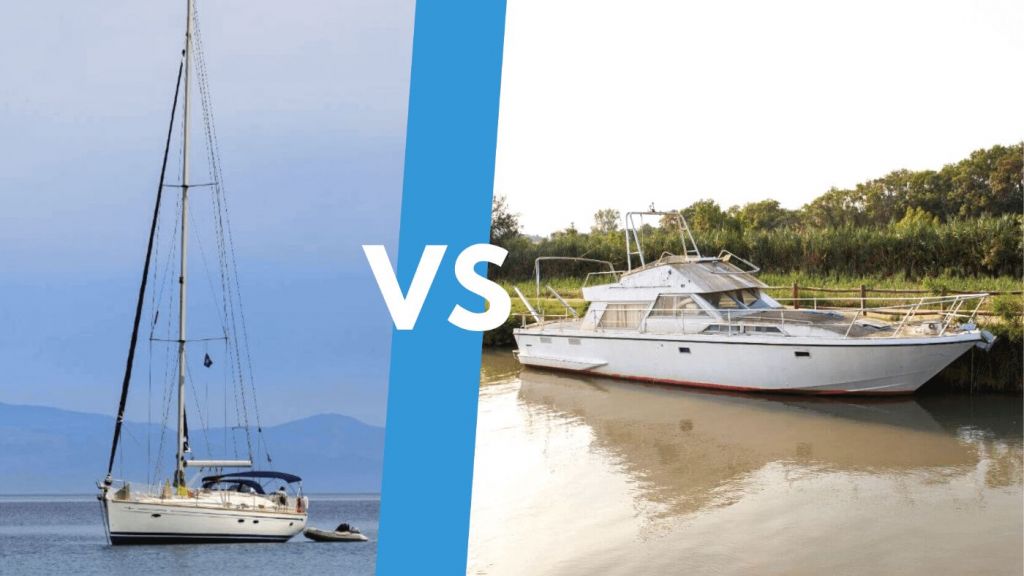
Considerations for a liveaboard boat:
What type of boat is the best liveaboard, peace of mind, ease of use, communication devices, the romance of it all.
In deciding which boat type is best to live on, you need to consider the following categories:
- Comfort - here it is a tie
- Speed - here powerboats win
- Peace of mind - sailboats are a winner
- Cost - sailboats win again
- Ease of use - powerboats take the prize
- Communication - slight win for sailboats
- Ecology - sailboats win
- Romance - subjective, but sailboats tend to win
First of all, a small word of caution - while researching the age-old 'sailboat vs powerboat' question, be careful when reading opinions - instead, look at simple facts. Unfortunately, this is a bit of a PC vs Mac kind of situation, with two zealous camps that would swear by their choice no matter what. Objectivity is tough to find.
So remember - it is all about facts and how these suit your specific needs. I myself do have a bias but will keep it to myself. I've spent a fair amount of time on both sailboats and powerboats, so I'll just be honest, and will let you choose.
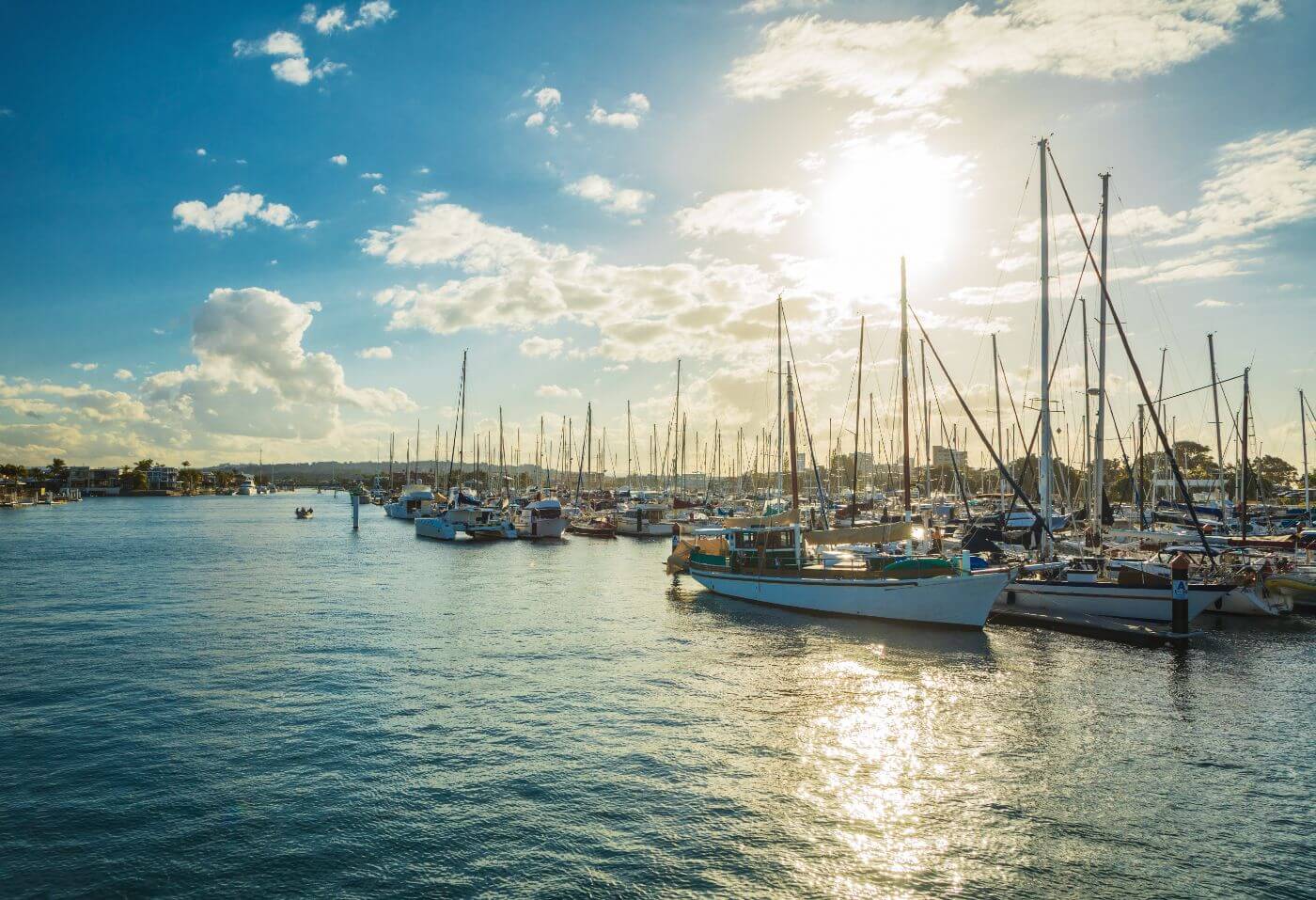
Since we are talking about liveaboards, let's start with comfort, because over time, that will become one of the most important aspects for most.
There is no clear 'winner' in this category, as there are pros and cons to both, but when we get to the subcategories, things start to be a bit more clear.
So, for instance, when it comes to space, powerboats tend to be more open. By design, they are usually boxier, which makes for a larger amount of interior space.
Sailboats, on the other hand, take hydrodynamics into account, so their hulls are narrower and sleeker, which is great for efficiency but eats away at the space.
The same goes for deck space. Since on a powerboat, there are no masts, sails, or lines to get in your way, it is more comfortable to move around. Powerboats also often have a flybridge, creating another 'floor' which adds to the overall usable space. And adds a whole lot to visibility.
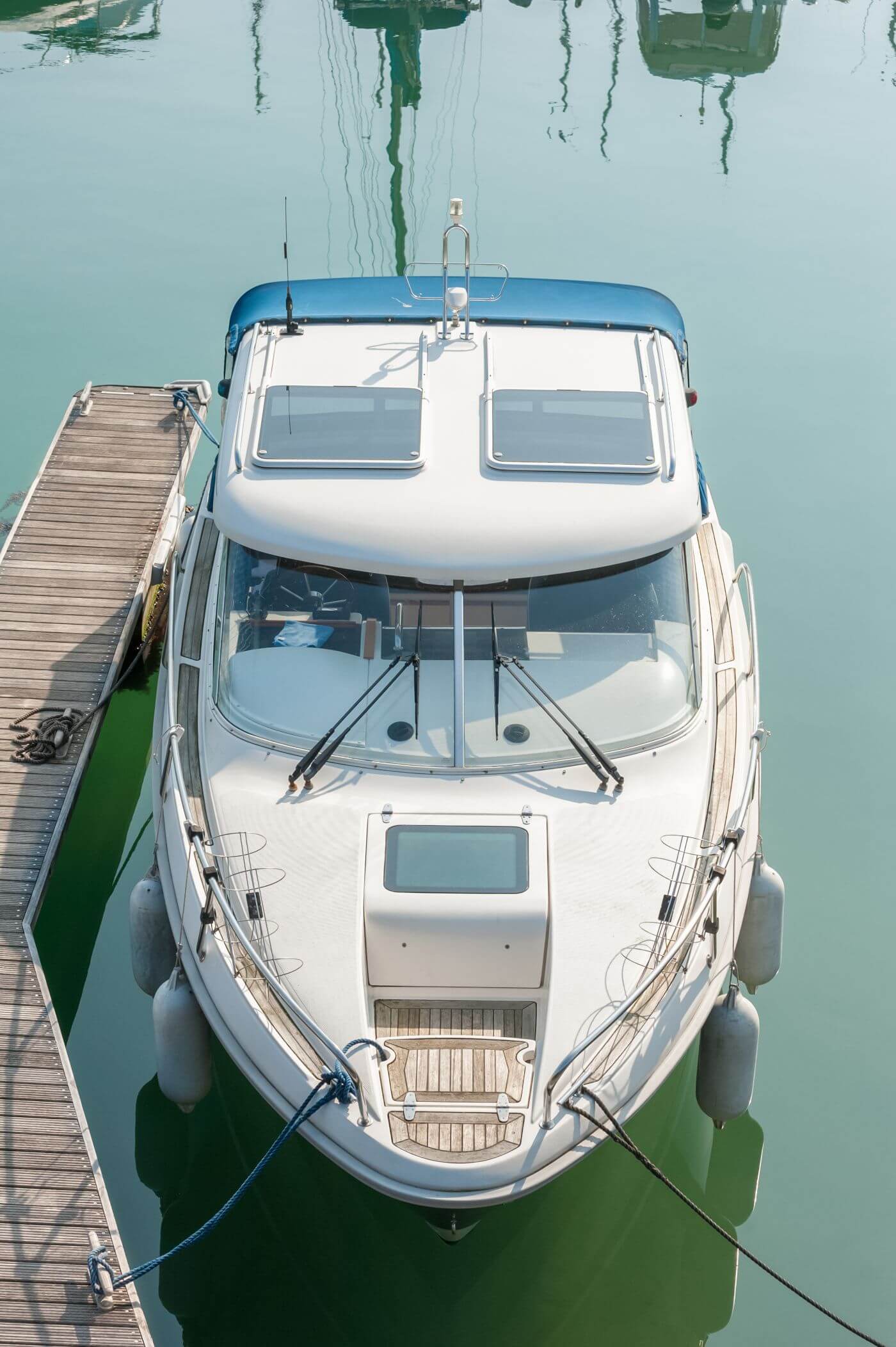
Things change quite dramatically when we get moving or into rougher seas, though. Thanks to the heavy and deep-reaching keels, sailboats are way more stable and will keep more level.
As opposed to powerboats that don't have these keels, have shallower drafts, and as a result, high center of gravity, so the movement of the waves translates to the hull a lot. They dance around on waves, so expect plenty of broken mugs and hard times when cooking.
The seasick ones will suffer, and so will comfort. This is to such an extent that smart people of the world developed gyroscopes for powerboats that keep them more level. But that is a solution for larger boats only, and it's also an expensive and power-consuming one.
Then again, when under sail, sailboats heel, especially if going 'against' the wind. Meaning your world will suddenly shift potentially tens of degrees. Those who don't like heeling, be aware.
When talking about comfort, I gotta mention the noise and vibrations. When I was speeding around the islands of Croatia on a 46 ft Jeanneau powerboat, I honestly dreaded the moments under power and couldn't wait to get to my destination so I could turn the engine off. Even if you enjoy the roar of a motor, it gets seriously annoying after a while.
For liveaboards, speed usually isn't a priority, but you should know what to expect from your purchase.
Yes, powerboats are generally faster than sailboats. The average cruising speed of a sailboat is somewhere around 6 - 8 knots, while powerboats can easily go around 20 or more if you put your foot down.
But wait, there is a twist! You see, the hull speed is the same for both sailboats and powerboats. Once you want to go over it, the power demands increase drastically, and the power to speed efficiency curve just drops to hell.
Now whether that is good or bad depends on whether you mind that or not. We will discuss cost, comfort, and other implications of high fuel consumption later. But it is safe to say that for passages where efficiency is a thing, the powerboat's power actually doesn't bring much extra speed.
But to be fair, powerboats pick a direction and go straight towards it. Wind power and direction have less influence on their speed and direction than on that of sailboats that have to tack, meaning they have to go a longer route and whose speed drops with the wind.
Very important factor. After all, it is supposed to be your home, and if your home doesn't bring you comfort but rather constant stress, it isn't much of a home, is it? So peace of mind is a big part.
Now there isn't a huge difference between the reliability of a powerboat and a sailboat. They both respond similarly to crashes and waves rolling over them, though a sailboat is harder to capsize.
What needs mentioning is the means of propulsion. Accidents happen, and if your engine breaks on a powerboat, you will either have to tow yourself with a dinghy if you have one, or pay for a tow service.
Neither is a very comfortable option if you are in the middle of a long passage, hundreds, if not thousands of miles from the coast.
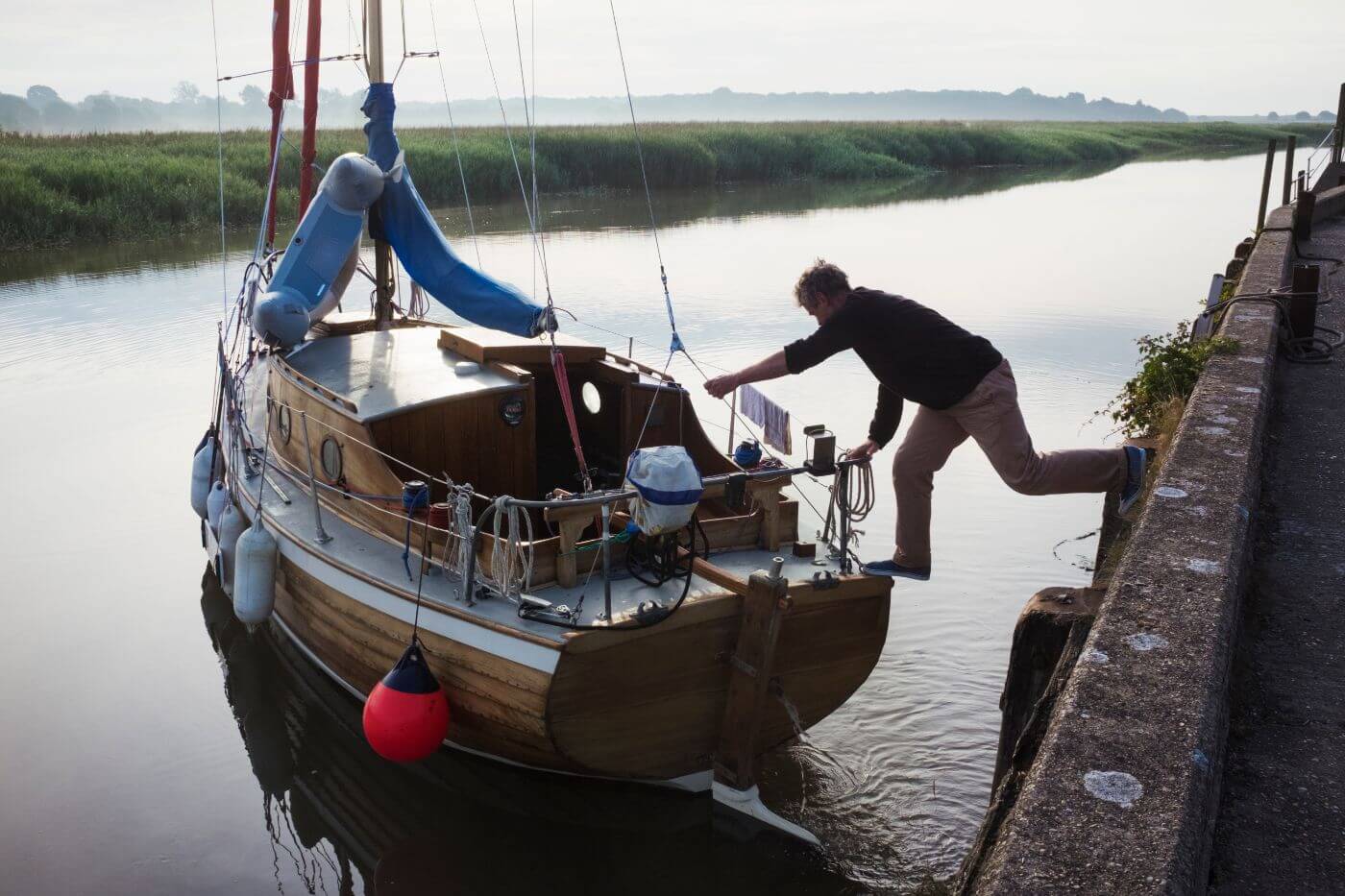
A sailboat, on the other hand, has an engine, mainsail, and the foresail, so unless all three of these break, you always have a backup. Actually, even if your sails rip and mast breaks, there is a fair chance you will be able to fashion some sort of a sail to get moving.
This ties into another topic, which is the range. A sailboat has, theoretically, an unlimited range . That gives you peace of mind when planning journeys since you won't have to calculate how much fuel to take on longer journeys and whether there are fuel stop options on the way. And if you realize your passage is too long for your diesel tank, you won't have to fill your boat with stinky fuel cans.
Unless you've got an electric engine and solar panels, that is. Which is a thing these days, one I hope to see more of.
Of course, we have to talk about the cost of it all. This will be a deciding factor for many. Let's first address what's on everybody's mind - fuel. A powerboat will consume large amounts of it, and it costs.
With a consumption of around 6 l/nm, the aforementioned Jeanneau ate up around $1,100 daily on fuel, and though we were covering quite a lot of distance that a liveaboard necessarily wouldn't, this isn't a negligible budget item for many.
Sailboats have motors too, but they don't use them that often and even if they did, all the time, because of better hydrodynamics, they need less fuel to get around.
Moving on to upkeep costs, with sailboats you'll need to pay for the maintenance of sails and rigging. Most boat owners replace sails every 5 - 10 years, and for a 30 something footer, this will cost around $4,000. Give or take a lot depending on the usage, materials, and all that jazz, but you get the point.
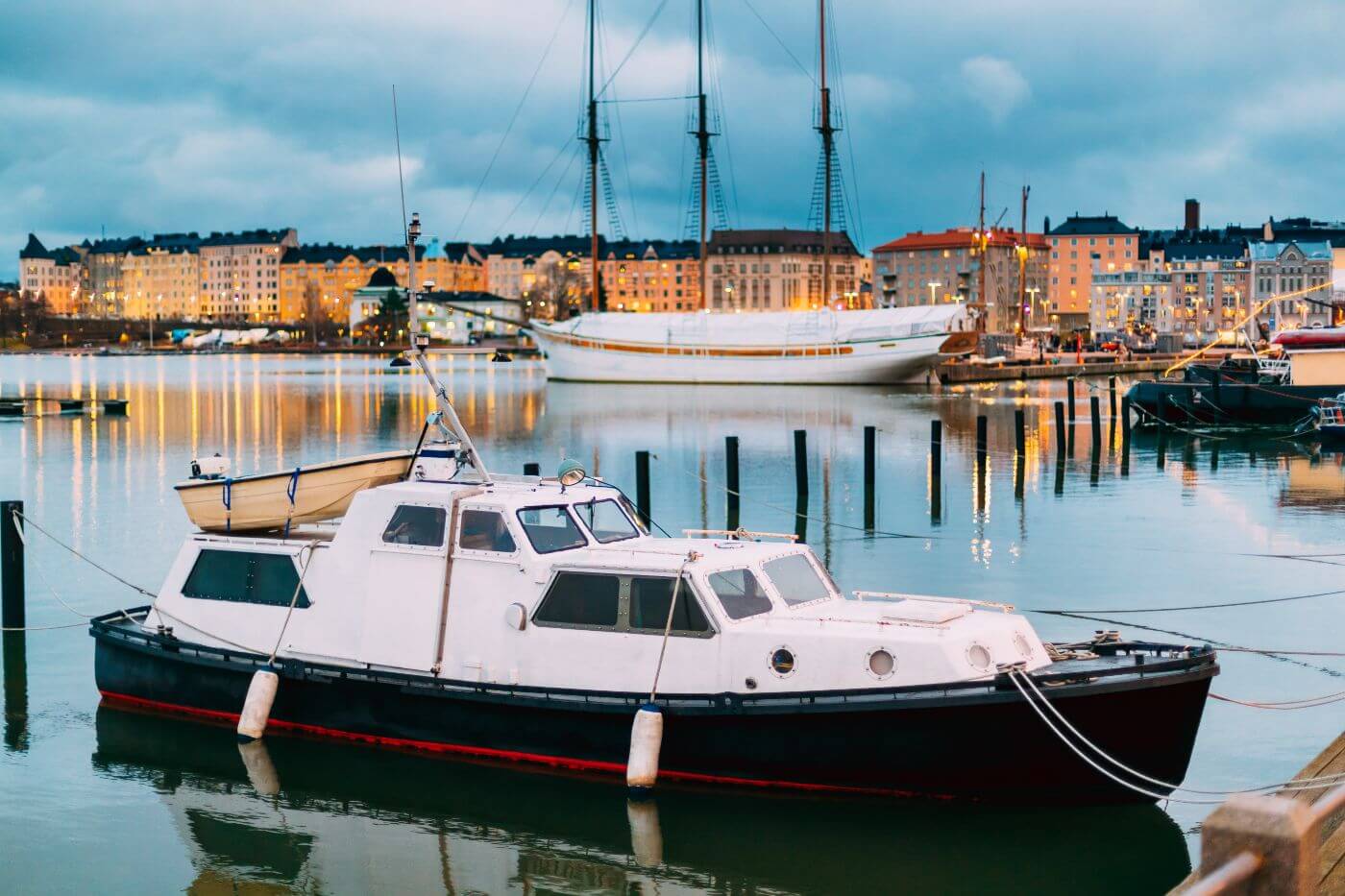
Then again, powerboat engines are significantly more expensive, and since they are used more often, they will require maintenance and replacement more often. So all in all, none is a clear winner when it comes to maintenance costs.
Last but not least, there is the purchase cost. This is a tricky one to answer - generally, powerboats are more expensive to purchase, but when buying a boat, there are so many variables to consider, like size, power, condition, equipment, that you would be better off looking at specific offers that are in your geographical and financial range than going by a rule of thumb.
Unlike the previous matter, this has a clear winner. Powerboats are way easier to use. They require less upfront knowledge to get from point A to point B.
If a person who has never been on a boat gets on a powerboat, I am confident they will be able to get to their destination without much hassle (if the seas are calm).
On the other hand, operating sails isn't intuitive. On the contrary, I mean - sailing against the wind? What the hell, right? Yet it is possible.
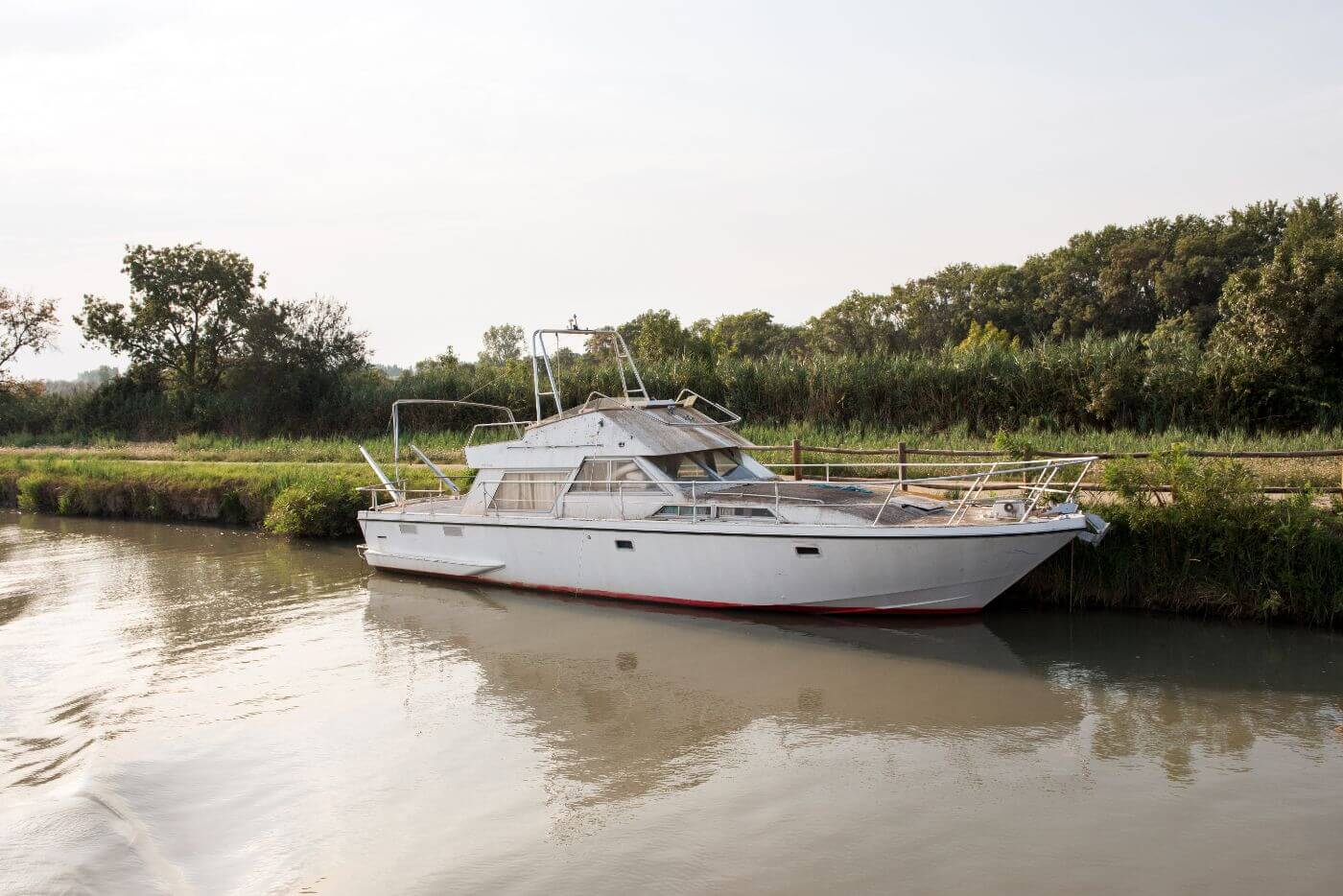
On a powerboat, you just press a lever and go; not much more effort is needed. On a sailboat, you gotta move around more and work with sails. Now whether that's a good or a bad thing I'll leave up to you.
I'm not sure if this belongs here or to the 'peace of mind' category, but powerboats have a much shallower draft.
With a sailboat, you need to be aware of your keel that goes several meters deep, and you won't be able to go to shallow places that would be reachable by powerboats.
In practice, this isn't really a thing that would make your sailing experience any different from that on a powerboat, but you gotta be mindful of it when going close to the shore.
This is something to think about, though it isn't often considered. The main communication tool of sailors is the VHF, which is a line of sight thing. So having a tall mast to put your transmitter on is a definite plus as you will gain miles and miles of additional range.
Then again, with satellite communications, you have to take into account mast shadow, which creates interference - something powerboats don't have to deal with.
I know, I know, many of you are rolling your eyes now. But the greenness of it all is a hot topic these days and is becoming hotter every year (Global warming joke, get it? Haha.). So there is a fair chance that many of the aspiring boat owners take this into account too.
And the winner here is clear - unless you've got a solar-powered boat, a sailboat is a much more eco-friendly option. And your home won't be called a 'stinky' by the fellow seamen.
This one is rather intangible, and some might say unimportant - but let's be honest, it is what we all got into sailing for, not for spacious salon layouts, good mileage, or hydrodynamic hulls, but for the romance of it. Now which side you will stand on here is a matter of opinion rather than something you can measure, so I'll give you mine, and you see what you wanna do with it.
On powerboats, you get the feeling of power and speed that an equally priced sailboat just won't provide. Which is cool, I gotta give them that.
But sailing to me seems more romantic. Not in the hearts and flowers kinda way, but in the Jack Sparrow one. You feel free, the sense of adventure is there, sailboats seem to have a soul that powerboats don't.
Powerboats are a set of parts that go, but on a sailboat, all these parts put together create freedom. And yes, I kinda stole Jack Sparrow's quote here.
I've heard somewhere that when you get on a powerboat, you do it to get somewhere. But when you get on a sailboat, you're already there.
I'm not exactly sure why, perhaps it is the unlimited range, thus the possibility to theoretically go anywhere without needing much, perhaps it is the fact that a sailboat is more in tune with the sea and weather and wind, but it just feels homier.
And finding this homey feeling on the sea is what you came here for.
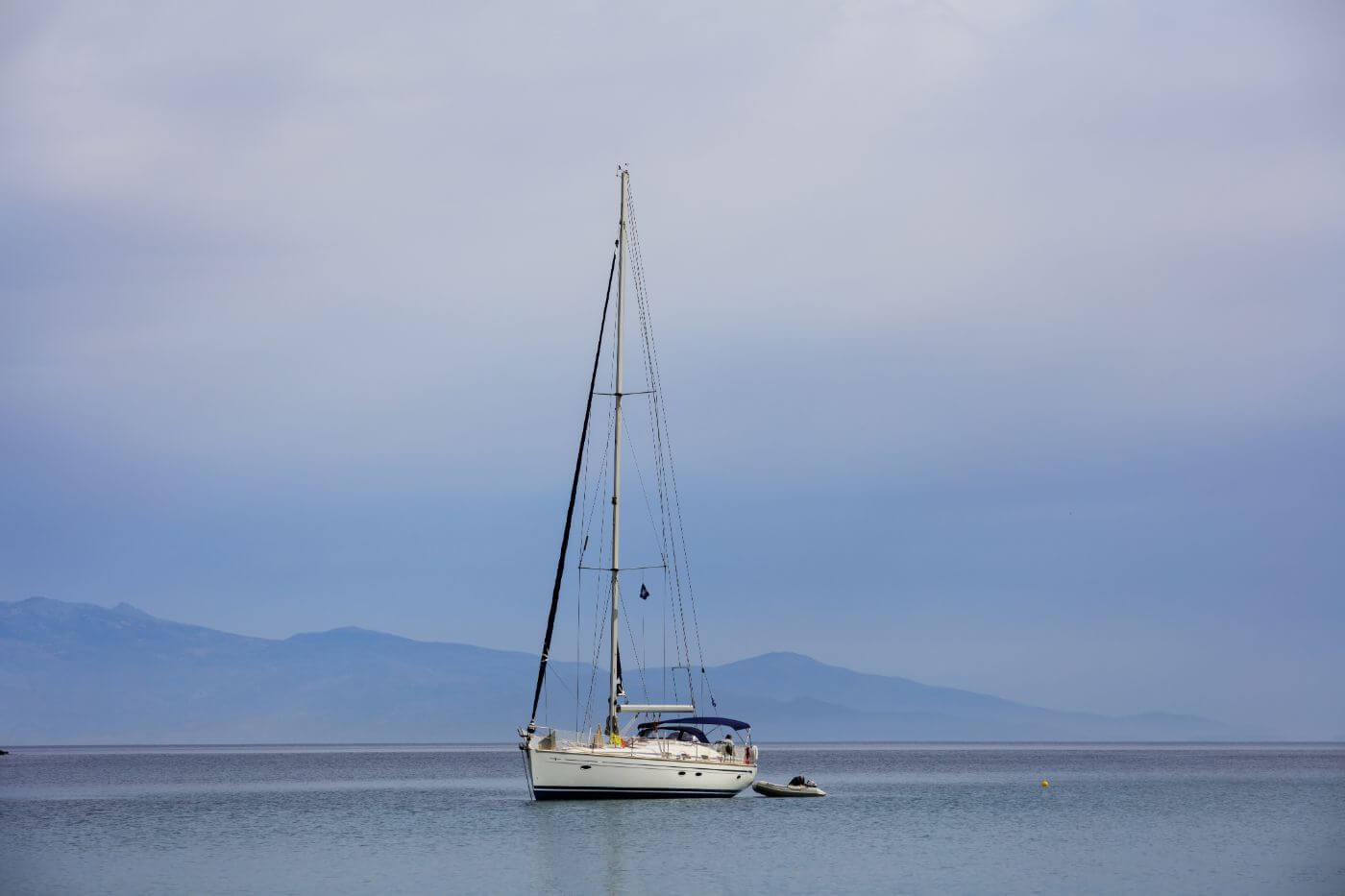
Leave a comment
Get Busy Boating
Boat vs. Personal Watercraft: Here’s The Difference

If you’re in the market for your first water-faring vessel, then you may wonder about the differences between a boat and a personal watercraft. In this explanatory guide, I’ll tell you everything you need to know.
What are the differences between a boat and a personal watercraft? Boats and personal watercraft are different in areas such as vessel shape and size, speed, storage, carrying capacity, maintenance, and price.
If you want to learn even more about what separates personal watercraft and boats, this guide will explain more fully. By the time you’re done reading, you’ll know which vessel you should buy!
What Is a Boat?
Technically, a boat is a watercraft, but it’s not a personal watercraft. (If that doesn’t yet make sense, it will soon).
Boats come in a variety of sizes, shapes, and styles, but what separates them from ships is their size. Ships are larger and thus have a greater carrying capacity than boats.
A boat can be used in all sorts of different bodies of water, from placid bodies like lakes and streams to bays and oceans.
Boats are also available powered or unpowered. A powered boat requires those on board to use a pole, paddle, or oar to manually propel the boat forward as well as do other maneuvers.
A powered boat usually has an engine, be that an outboard or inboard engine, that allows the boat to reach variable speeds on the water. Batteries, a steam engine, and an internal combustion engine are other sources of power.
An engine needn’t always be the source of power. A boat with sails is also considered a powered vessel. The boat would rely on the wind to navigate.
The Types of Boats
There are many, many types of boats out there. Perhaps in the future, I’ll explore the full list, but for now, I just want you to have a clear idea of what constitutes a boat.
Thus, these are the most popular types of boats.
- Banana boat: No, not like the sunscreen company. A banana boat is an inflatable boat shaped, appropriately enough, like a banana. Often used for cargo, a banana boat can carry passengers as well, usually up to 10.
- Jon boat: Jon boats are flat or almost flat bottom boats commonly made of polyethylene (plastic), aluminum, fiberglass, or even wood sometimes. They’re often rectangular in shape with a blunt nose. Jon boats are relatively cheaper than other boats and easier to transport due to their being lightweight.
- Ski boat: Ski boats are inboard boats with a unique propeller and engine configuration that allow the boat to achieve fast speeds.
- Pontoon boat: The classic pontoon is a large, rectangular, flat, slow-traveling boat. Supported by dual pontoon tubes, a pontoon can be as large as 30 feet and carry large numbers of passengers. Pontoons are beloved for their stability.
- Jet boat: If you have the need for speed, a jet boat will satisfy. These highly maneuverable boats feature a propulsion system that sends water behind the boat as you race.
- Lifeboat: You don’t use a lifeboat for recreational boating, but rather, these types of boats exist to save lives. A lifeboat will carry life jackets, medical supplies, and possibly food and water as well.
- Motor yacht: An upscale type of boat, a motor yacht includes up to two engines, typically diesel engines. These boats turn heads and make people yearn for the good life on the sea.
- Cabin cruiser: An enclosed type of boat, cabin cruisers are very luxurious as well. The boat has a galley and runs on a generator so it can offer air conditioning. Designed for saltwater bodies, a cabin cruiser utilizes rudder steering, a wide berth, and a deep V-shaped bottom.
- Game boat: A game boat is for game fishing. With a fiberglass shell and gas or diesel engine, a game boat features a cooking galley, plumbing system, and sleeping quarters so you can take an extended fishing trip.
- Runabout boat: A runabout boat is a casual type of boat for water skiing, fishing, and boat racing. The capacity of one of these boats is tremendous, as a runabout can fit upwards of eight people.
- Trawler boat: Another style of fishing boat, a trawler features a displacement hull and a slow speed. The fuel efficiency is great so you can travel longer without going through your fuel supply.
- Cuddy cabin: A cuddy cabin has an aluminum or fiberglass skeleton, fishing features, plenty of storage, and an enclosed deck. You can also use a cuddy cabin for watersports.
- Catamaran: The sailing catamaran has two long hulls equidistant to one another. Each hull lacks volume but has a shallow draft and a high rate of displacement. You can cruise on one of these boats for a fun day trip. Catamarans come in handy for fishing too.
- Center console boat: A center console boat is the one for you if your boating adventures sometimes take you off the beaten path. Designed for offshore waterways, even the rougher ones, a center console also makes an excellent fishing vessel.
- Dinghy boat: A dinghy refers to a sailboat, rowboat, or inflatable boat. These are non-powered boats that require you to use sails or oars to steer. Some might have outboard engines, but this is considered uncommon.
- Houseboat: Houseboats are designed for full-time living on the water. While that’s not for everyone, houseboats have what you need, including plenty of amenities inside for sleeping, cooking, bathing, and living.
- Deck boat: A deck boat is a boat measuring 25 to 35 feet long. The boat is characterized by its wider beam, V hull, and power drive. Deck boats have even more room for passengers than you would expect!
- Bowrider: Considered a good family boat, a bowrider offers a swimming platform for diving, plenty of space, and room for at least eight people. The V-shaped hull allows a bowrider to traverse all sorts of waters.
What Is a Personal Watercraft?
Next, let’s switch gears and discuss what a personal watercraft is.
A personal watercraft is sometimes called a jet ski, a water scooter, or simply a PWC.
You can select from two personal watercraft styles, the first being a stand-up PWC and the second a sit-down PWC.
A stand-up personal watercraft requires the rider to–as you might have guessed–stand while riding.
A sit-down personal watercraft, which is sometimes referred to as a runabout, allows the rider to sit while riding.
Jet skis and other types of personal watercraft feature an inboard engine. The engine activates a pump jet with an impeller that allows the rider to steer and receive enough thrust to move forward on the water.
Boat vs. Personal Watercraft
Now that you have a much clearer picture in your mind about what a boat and personal watercraft are respectively, let’s go over the differences between boats and personal watercrafts.
Boats come in a multitude of shapes, as the section on the various types of boats should have proven.
Some are large and boxy such as pontoon boats. Many more feature refined V-shaped hulls.
There’s a reason for this recurring feature. A V-shaped hull enables a boat to slice swiftly and easily through the water, which also increases the boat’s speed potential (more on this to come).
That’s why you so commonly see personal watercraft with V-shaped hulls as well.
PWCs, like boats, are on the market in a variety of sizes.
- Sit-down personal watercraft can measure anywhere from 40 to 50 inches wide and 120 to 130 inches long.
- A stand-up personal watercraft has an average width of 25 to 30 inches and a standard length of 80 to 100 inches.
Some boats are sized about the same as a personal watercraft.
Much more often though, a boat will outsize a PWC by a significant margin, especially if we’re comparing a jet ski to a pontoon boat, a houseboat, or a yacht.
Storage Capacity
Whether you’re taking a day trip with your entire family or even plan on staying a night or two on your vessel, storage capacity is important.
You can’t exactly camp out on a personal watercraft. The vessel simply doesn’t have the size or the amenities for that.
Thus, the storage capacity is about commensurate with what you’d expect of a PWC’s size. You might have front, under-seat, or rear storage, but we’re talking storage compartments. That’s all.
These compartments are designed to hold your phone, some drinks, a few snacks, and other essentials, but nothing extensive.
Boats, given that they’re usually larger than PWCs, do have a greater storage capacity.
At the very least, you’ll find dedicated storage areas and cubbies for more significant storage than that mentioned above.
For enclosed boats designed for multiday boating excursions, you’ll have more ample storage still for keeping clothes, shoes, and everyday essentials safe from the water.
Passenger Capacity
A personal watercraft, at the very least, is made for a single passenger. At most, these vessels can carry four people.
PWC models with such a high passenger capacity are uncommon, though. More than likely, most personal watercraft you see will be able to carry two people, maybe three tops.
The passenger capacity of a boat varies by a huge degree.
Some boats are more intimate and only allow for two or three people including the driver. Other boats can easily carry groups of between four and eight people.
The biggest boats may easily be able to transport a dozen people.
Maintenance
When it comes to maintaining your vessel, is that easier to do with a boat or a personal watercraft?
While I would say that depends on the size of the boat, a PWC is generally the easier to maintain of the two.
The internal mechanisms that drive a personal watercraft are less complex than that of a boat, which makes the PWC easier to understand and thus personally upkeep.
A personal watercraft such as a jet ski is also often smaller than a boat as well. With fewer parts in general, be those moving or unmoving parts, you won’t spend as much time or as much money on maintenance.
Offseason Storage Options
A personal watercraft is small enough that you can lift it from the water, cover it, and store it in your garage until winter ends and the warm, long days fill the calendar again.
Granted, not all PWCs are that lightweight. Some weigh hundreds of pounds and others over a thousand pounds. You can’t lug those around nearly as easily.
When it comes to storing a boat, if yours is smaller, then you can follow the PWC storage method and slap a cover on the boat and stash it in your garage away from direct sunlight.
Much more often though, you’ll have to pay to keep your boat in an enclosed, climate-controlled environment.
The last significant difference between a boat and a personal watercraft is the price.
The average cost of a new jet ski is between $5,000 and $20,000, with most buyers paying somewhere in the ballpark of $12,500.
As for the cost of a new boat, it’s all over the map depending on the factors discussed above such as shape, size, and carrying capacity.
Here’s a list that goes over the types of boats and their accompanying prices when bought new:
- Yachts – $30,000 and up
- Cabin cruisers – $100,000 to $500,000
- Houseboats – $100,000 and up
- Trawlers – $90,000 and up
- Speedboats – $75,000 and up
- Cuddy cabins – $50,000 and up
- Fishing boats – $25,000 to $100,000
- Deck boats – $20,000 to $50,000
- Pontoon boats – $15,000 to $50,000
- Sailboats – $12,000 and up
- Bow riders – $15,000 to $50,000
- Catamarans – $10,000 and up
- Jon boats – $500 to $3,000
Unless you’re interested in buying a very simple boat for daytime use like a jon boat, then you’re going to pay significantly more money for a new boat than a new PWC.
Once you get into used boats versus used watercraft, the line can become blurrier.
Generally, older boats will sell for cheaper prices commensurate with the costs of a new jet ski.
If you want a newer used boat in better condition, you’d still end up paying more for a used boat than a used personal watercraft.
Similar Posts
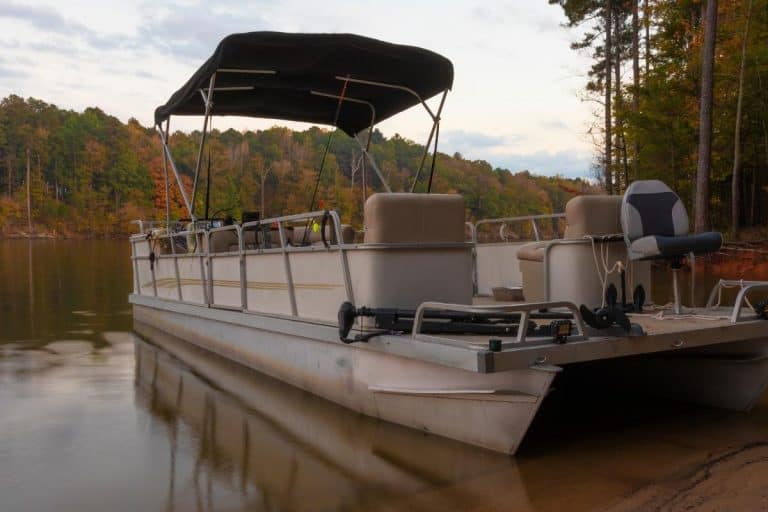
The Top 10 Reasons People Love Pontoon Boats
If you’re considering buying a pontoon boat, but you’re just not sure if it’s the right type of…

What Causes the Most Fatalities on a Boat? You Might be Surprised!
Although you might not enjoy thinking about it, to be a safe and conscientious boat operator, you must…
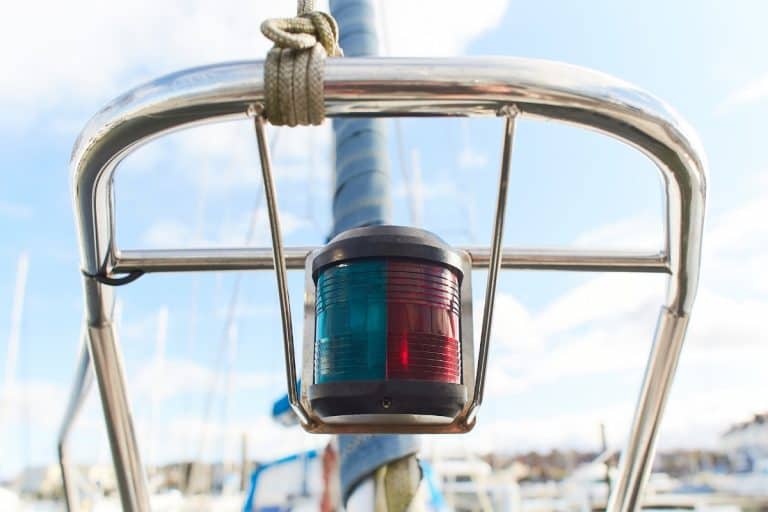
Why Do Boats Have Green and Red Lights on Them?
You’re still new to boats, and you’re wondering what the green and red lights on your boat are…
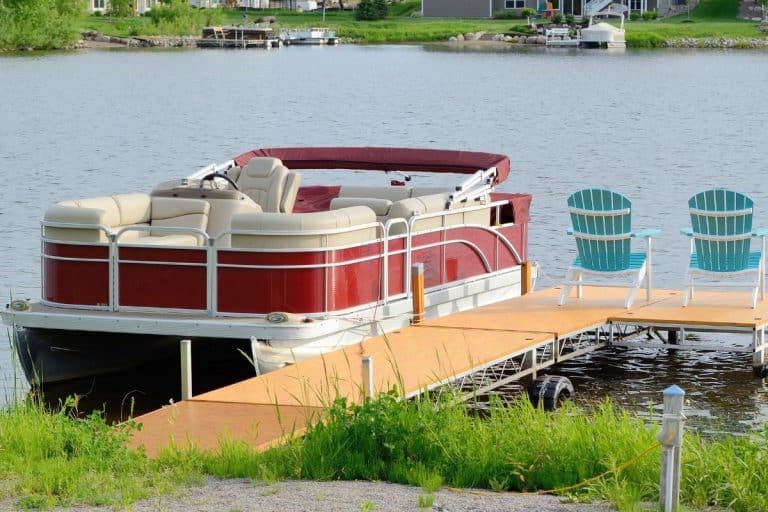
Are There Beginner Pontoon Boats? (You Might Be Surprised)
Through reading getbusygetboating, you’ve become utterly intrigued by pontoon boats. You have some boating experience, but not with…

3 Ways to Make Your Inflatable Boat More Durable
Although inflatable boats are usually more affordable than other boat types, you still don’t want yours to prematurely…

Do Pontoon Boats Hold Their Value? You Might be Surprised
If you’re thinking of purchasing a pontoon boat, one of the questions you’ll undoubtedly have is whether this…
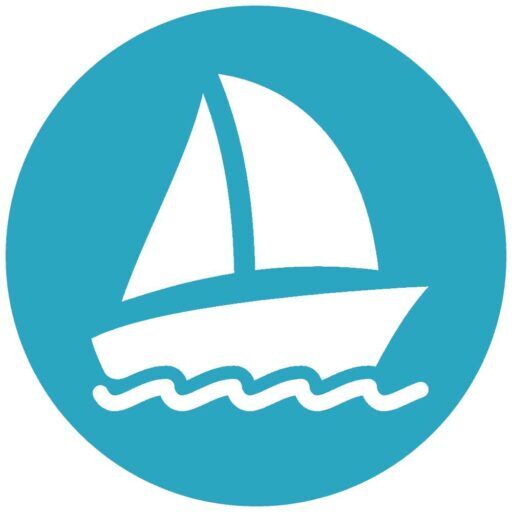
WaterCraft 101
Your guide to fun on the water!
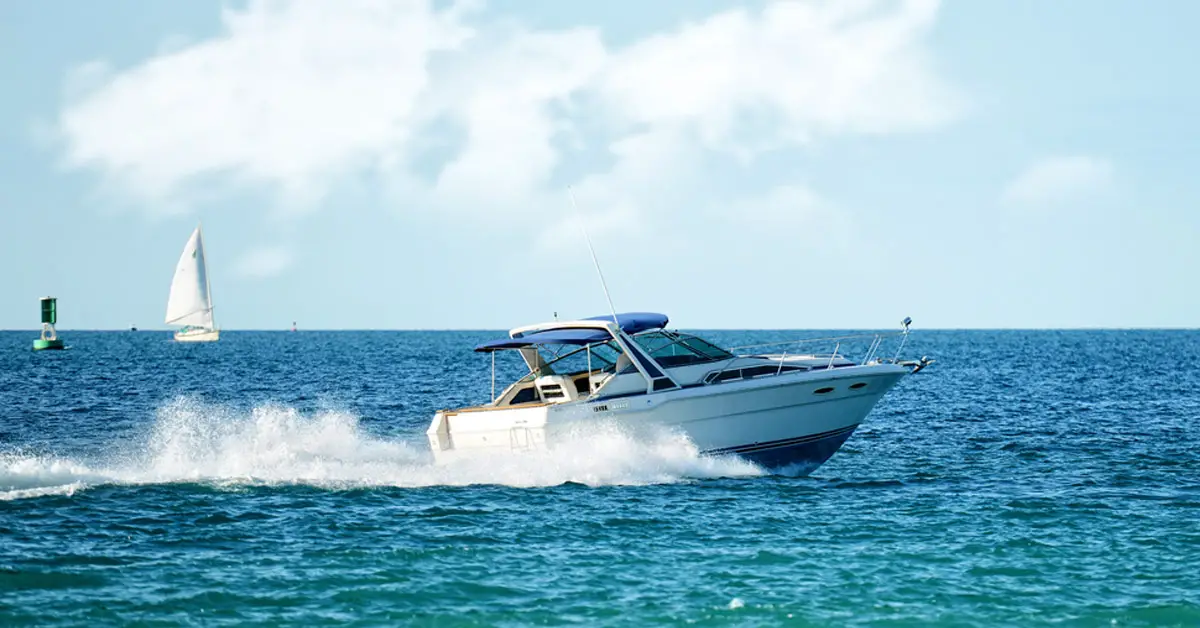
Sailboat vs. Powerboat: Which Is the Give-Way Vessel? Understanding Navigation Rules on the Water
Navigating the waters is an exciting adventure, whether you’re at the helm of a sleek sailboat or commanding a powerful motorboat. However, along with this thrilling journey comes the responsibility of understanding and adhering to the marine navigation rules, specifically those concerning the right of way or the “give-way” vessel. This aspect is vital to maritime safety, ensuring orderly movement and preventing potential collisions on the high seas.
Under the International Regulations for Preventing Collisions at Sea (COLREGs), a powerboat is typically the give-way vessel when encountering a sailboat under sail. The powerboat should alter its course to avoid a collision. Always confirm specific situations with local and international rules.
This article will delve into the intriguing debate between sailboats and powerboats. We’ll dissect the intricate navigation rules on the water, shedding light on the factors determining which boat must yield.
This piece promises to be an enlightening read for seasoned mariners and beginners alike, providing essential information for anyone who wishes to tackle the waves responsibly. Remember, knowing these rules isn’t just a matter of etiquette—it’s a crucial component of maritime safety.
Table of Contents
Introduction to Nautical Navigation Rules
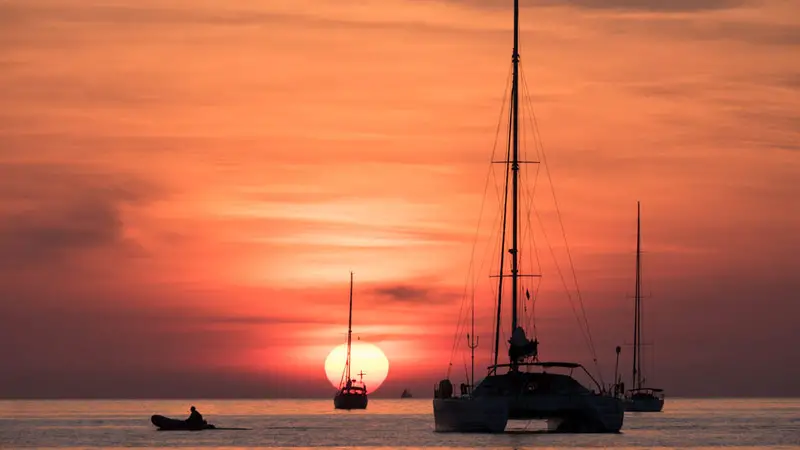
Navigating the vast expanse of our world’s waters requires skill and a profound understanding of maritime movement rules. These rules, known as the International Regulations for Preventing Collisions at Sea (COLREGs), have been established by the International Maritime Organization (IMO) and are adhered to by seafarers worldwide. They provide a comprehensive framework for nautical navigation, ensuring that all vessels move in a safe and orderly manner.
Key points in understanding nautical navigation rules include:
- Understanding COLREGs: COLREGs are the universal road rules for boats and ships worldwide to prevent collisions between two or more vessels.
- Right of Way or Give-Way Rules: These rules determine which vessel is responsible for keeping out of the way in encounters with other vessels to avoid collisions.
- Sound and Light Signals: COLREGs establish a system of sound and light signals so vessels can communicate their intentions in various scenarios, especially in poor visibility.
- Navigation Lights and Shapes: Vessels must display specific lights and shapes in different situations to indicate their status to other vessels.
- Steering and Sailing Rules: These rules determine vessels’ actions in the sight of one another to prevent collisions.
- Special Circumstances: There are also rules for special circumstances, such as vessels not under command, constrained by draft, engaged in fishing , or sailing in narrow channels.
Understanding the Concept of the Give-Way Vessel
Understanding the concept of the give-way vessel is fundamental to maritime navigation. In nautical terms, a ‘give-way’ vessel refers to the boat required to alter its course or speed to avoid colliding with another boat, the ‘stand-on’ vessel. Essentially, the give-way vessel must yield to the stand-on vessel.
These designations help create an orderly flow of traffic on the water and significantly reduce the risk of collisions. It’s important to note that these roles can change based on various factors, including the type of vessels involved, their relative positions, and the environmental conditions.
The responsibility of the give-way vessel does not absolve the stand-on vessel of all duties. If it becomes apparent that the give-way vessel is not taking appropriate action to avoid a collision, the stand-on vessel must take evasive action.
Regardless of their designation, both vessels share a mutual obligation to avoid incidents at sea. Understanding these dynamics and responsibilities is crucial for all mariners, as it contributes to safer navigation and fosters a culture of mutual respect and cooperation on the waterways.
Sailboats vs. Powerboats: A Basic Overview
Sailboats and powerboats represent two distinct modes of marine transportation, each with unique characteristics, advantages, and challenges. Sailboats, propelled primarily by wind action on their sails, offer an eco-friendly, serene, and often sportive seafaring way. On the other hand, powerboats, driven by mechanical engines, provide speed, power, and often more control, particularly in challenging weather conditions. Each type requires different skill sets and knowledge to operate safely and efficiently.
Key characteristics of sailboats and powerboats include:
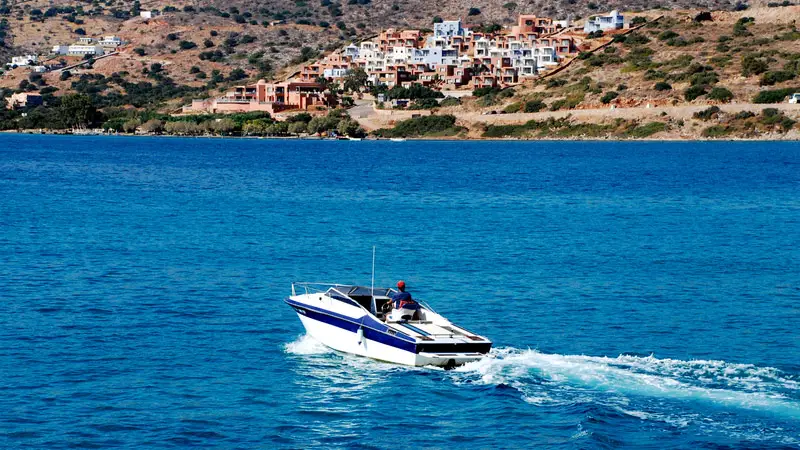
- Propulsion: Sailboats rely on the wind acting on sails, rigging, and hull for propulsion. In contrast, powerboats use engines (inboard, outboard, or stern-drive) for movement.
- Speed: Powerboats generally offer higher speeds than sailboats, making them suitable for water skiing, racing, or quick transportation. Sailboats, being wind-dependent, can’t match the speed of a motorboat but offer a more leisurely pace.
- Maneuverability: Powerboats usually have superior maneuverability due to their engines. Sailboats, reliant on wind and currents, require more skill and understanding of these elements for effective control.
- Fuel efficiency and environmental impact: Sailboats are more environmentally friendly and fuel-efficient as they use wind power. Powerboats rely on fuel, which leads to emissions and potential environmental impact.
- Skills and knowledge required: Operating a sailboat requires knowledge of sailing techniques and wind patterns. Powerboat operation is typically more straightforward but requires an understanding of engine operation and maintenance.
The Role of a Powerboat in Marine Traffic
Powerboats play a significant role in the vast and diverse arena of marine traffic due to their speed, maneuverability, and versatility. These vessels can range from small personal watercraft and motorboats to larger yachts and ships, all powered by engines.
Their mechanical propulsion allows them to move independently of wind and current conditions, giving them an advantage in certain navigational situations. They can quickly respond to changes in direction, making them particularly valuable in congested waters or emergencies.
However, this power and speed come with responsibilities. Powerboats are generally considered the give-way vessel when encountering sailboats under sail, mainly because they have more control over their course and speed. They are expected to be vigilant and proactive in avoiding collisions, altering course or speed as needed.
Also, due to their potential to create a significant wake, powerboat operators must also be mindful of their vessel’s impact on other boats, wildlife, and shoreline erosion. Thus, the role of a powerboat in marine traffic extends beyond its capabilities—it includes the duty to navigate responsibly for the safety of all water users.
The Role of a Sailboat in Marine Traffic
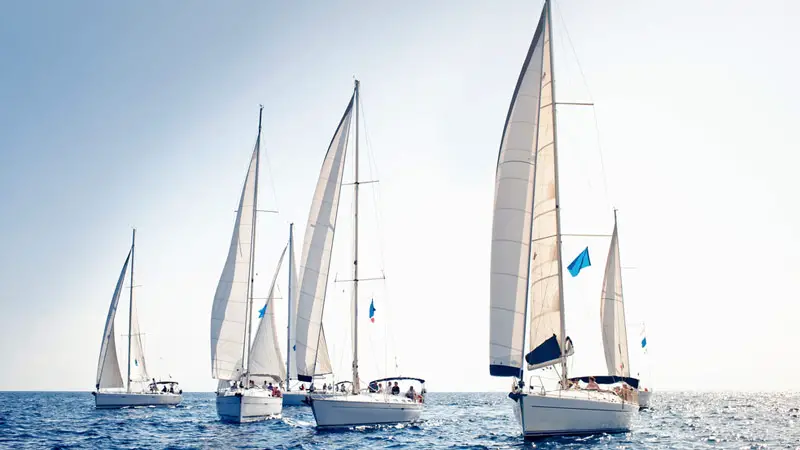
Sailboats hold a unique and enduring presence in marine traffic. They are characterized by their dependence on the wind for propulsion, using sails to catch and harness its power. These vessels, varying from small dinghies to large sailing yachts, offer a sense of tradition, adventure, and connection with nature that is often unmatched.
Sailboats can navigate in areas with depth restrictions where larger powerboats cannot go, and their silence and absence of emissions make them an eco-friendly choice for seafaring.
Despite their slower speeds and lesser maneuverability than powerboats, sailboats generally have the right of way under the COLREGs when they are under sail and in a crossing situation with power-driven vessels. This rule recognizes the limitations of a sailboat’s maneuverability due to its dependence on wind direction and strength.
However, this privilege does not free them from the responsibility of maintaining a proper lookout and taking corrective action when it’s clear that the give-way vessel isn’t taking appropriate action or when both vessels are in such proximity that immediate action is necessary. Therefore, the role of a sailboat in marine traffic is not just about leveraging wind power but also about understanding and adhering to the navigation rules for everyone’s safety.
The Powerboat-Sailboat Encounter: Identifying the Give-Way Vessel
Navigating encounters between powerboats and sailboats is a fundamental aspect of marine safety. In general, according to the International Regulations for Preventing Collisions at Sea (COLREGs), the powerboat is usually the give-way vessel when encountering a sailboat that is under sail. This is because a powerboat with an engine is typically more maneuverable than a sailboat that relies on the wind for propulsion.
The give-way vessel, in this case, the powerboat, has the responsibility to take early and substantial action to avoid colliding with the stand-on vessel, which in this case would be the sailboat. This may involve altering the course, reducing speed, or combining both. These rules aim to create a predictable path for both vessels to prevent a collision.
However, it’s essential to understand that these rules can have exceptions based on specific scenarios. For instance, when a sailboat overtakes a powerboat, it becomes the give-way vessel, regardless of its propulsion method. Furthermore, if the sailboat is operating its engine and not clearly showing sails, it is considered a powerboat under the COLREGs.
Both powerboat and sailboat operators must know these rules to ensure safe navigation. Importantly, the ultimate rule is to avoid collision – even if this means the stand-on vessel has to give way. Knowledge, caution, and mutual respect are key to maintaining safety on the water.
Factors Influencing the Give-Way Decision For Boats
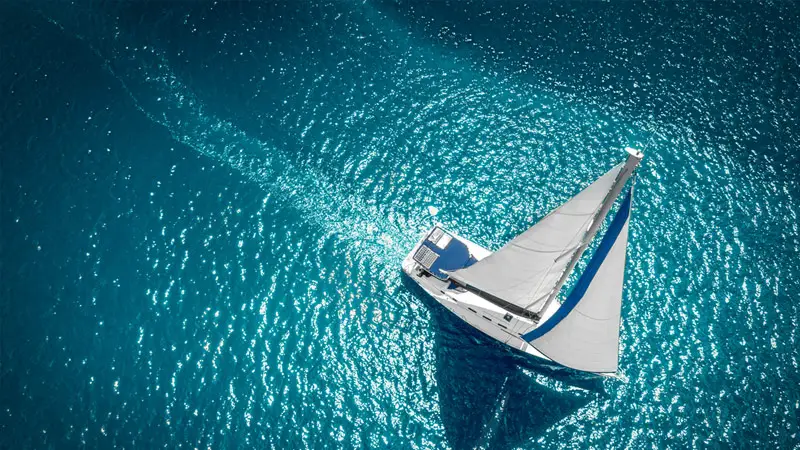
Several factors influence the decision of which vessel is the give-way vessel. These include the type of vessels involved, their relative positions, and the specific scenario they are in. While the general rule is that powerboats give way to sailboats under sail, there are exceptions and other factors that can change this rule. Understanding these factors is critical for safe navigation and collision avoidance.
Key factors influencing the give-way decision include:
- Type of Vessels Involved: The type of vessels involved in an encounter greatly influences the give-way decision. For example, vessels not under command, vessels limited in their ability to maneuver, boats constrained by their draft, fishing vessels, and sailboats generally have right of way over power-driven vessels.
- Relative Positions: The relative positions of the vessels also influence the giveaway decision. For example, a vessel overtaking another is generally the give-way vessel, regardless of the type of vessel involved.
- Operating Conditions of Vessels: Whether a vessel is under power or sail can influence the give-way decision. A sailboat under power is considered a power-driven vessel subject to the same rules as other vessels.
- Navigational Hazards: Navigational hazards may also impact the giveaway decision. A vessel in a position where it can safely navigate may be required to give way to a vessel closer to navigational hazards.
- Traffic Density: In areas of high traffic density, vessels may be required to maintain a higher level of vigilance and may need to take action to avoid collisions earlier than in areas of low traffic density.
Remember, while the give-way rules provide a framework for determining who has the right of way in a given situation, the ultimate responsibility of all mariners is to take whatever action is necessary to avoid a collision.
Special Situations: Exceptions to the Rule
While the general rules of navigation provide a solid foundation for maritime safety, there are special situations where exceptions to the rule apply. These exceptions account for the complexity and unpredictability of marine conditions and ensure that the primary goal of collision avoidance is always met.
- Overtaking Situations: Regardless of the type of vessel, the overtaking vessel is usually the give-way vessel. The stand-on vessel should maintain its course and speed, while the overtaking vessel should keep out of the way until it is past and clear.
- Narrow Channels: In narrow channels, all vessels should keep as near the channel’s outer limit on their starboard side. A boat shorter than 20 meters in length or a sailing vessel can not hinder the passage of a vessel that can navigate only in a narrow channel or fairway.
- Traffic Separation Schemes: In traffic separation schemes, a vessel should join or leave a traffic lane at the smallest angle to the general direction of traffic flow. A vessel should try to avoid crossing traffic lanes and should cross on a heading as close as possible to right angles to the prevailing traffic flow direction if obliged.
- Vessels Not Under Command or Restricted in their Ability to Maneuver: These vessels, due to exceptional circumstances, cannot maneuver as required by the COLREGs and are, therefore, usually given the right of way.
- Vessels Engaged in Fishing: Vessels engaged in fishing, when underway, shall have the right of way over other vessels, except those not under command or restricted in their ability to maneuver.
Bryan is a Las Vegas resident who loves spending his free time out on the water. Boating on Lake Mohave or Lake Havasu is his favorite way to unwind and escape the hustle and bustle of the city. More about Bryan.
Similar Posts
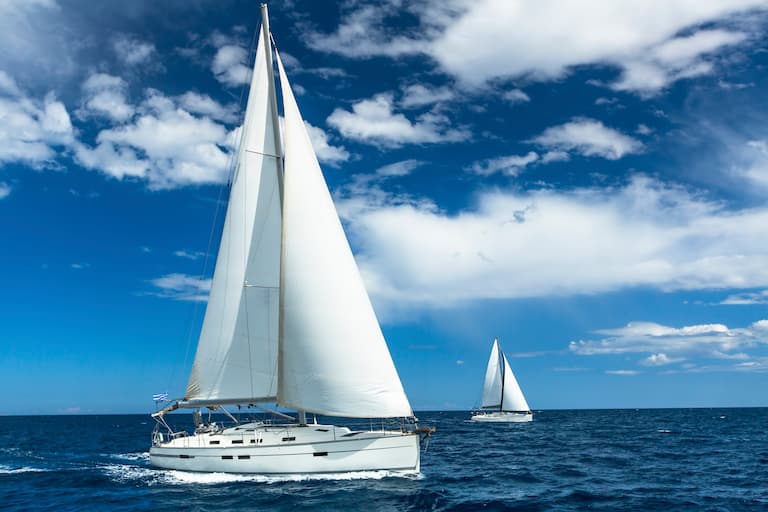
How Tight Should Sailboat Lifelines Be? (Need to Know!)
A lifeline is a safety device frequently found on sailboats and on construction sites. It’s composed of wire and stanchions, which are secured around the ship’s perimeter to prevent passengers from being thrown overboard or accidentally falling. But how tight should they be? Sailboat lifelines should be tight enough so they only stretch about two…
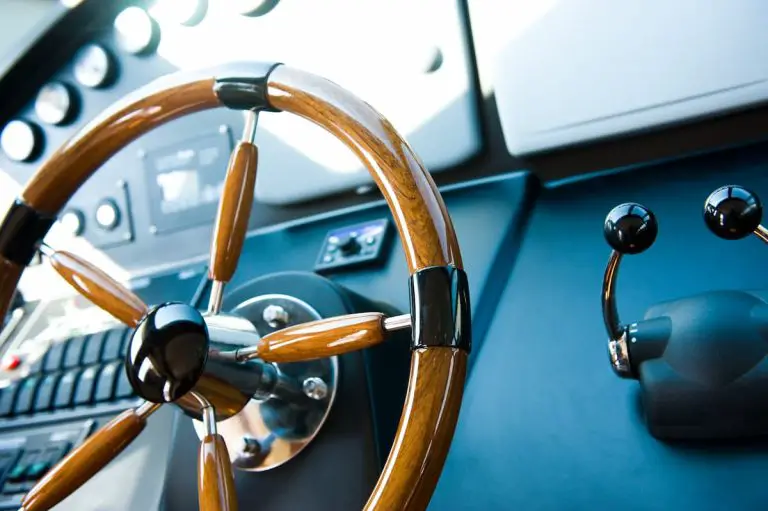
How To Fix Torque Steer on a Boat? (Complete Guide)
Torque steer is an issue peculiar to boats with single propeller systems. It happens when the engine attempts to pull the boat’s tail end in the same direction as the propeller spins when accelerating. This is a serious problem that needs to be addressed immediately, and luckily, there are a few ways to do that….
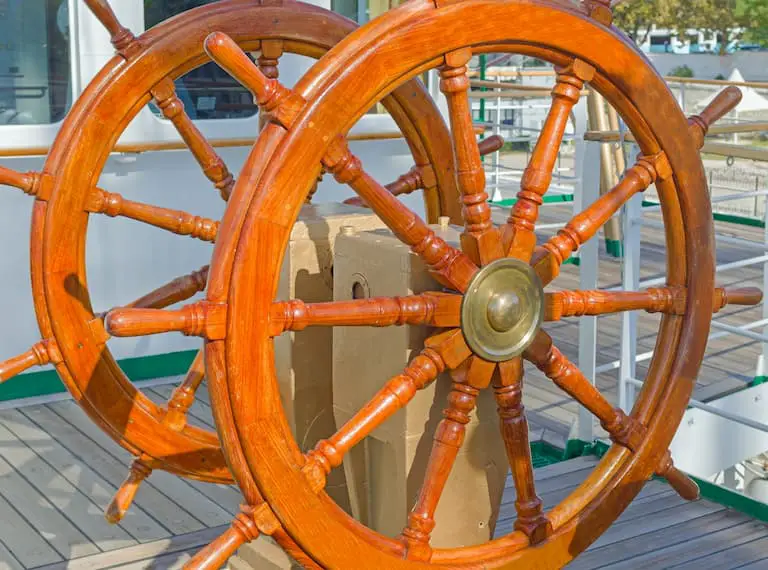
Why Some Sailboats Have Two Helms (Dual Helms Explained)
While most sailboats have a single helm with a steering wheel in the center, some larger sailboats or racing boats may have two helms. So, why do these sailboats have double helms? Are there any practical benefits of two helms on sailboats? Some larger sailboats have two helms as it helps with steering from different…
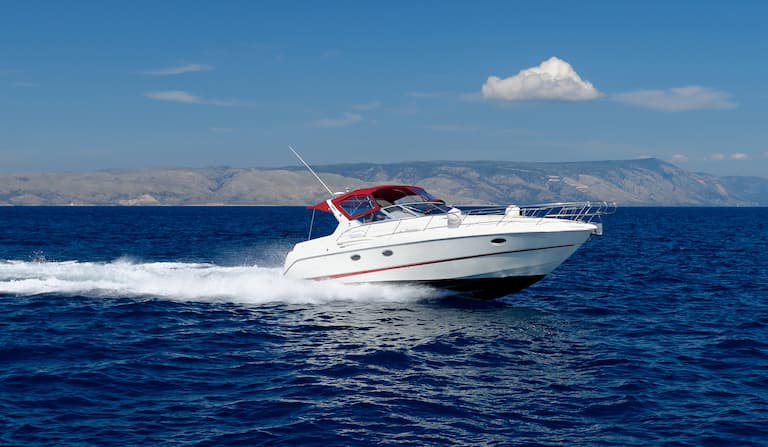
12 Reasons a Speed Boat Motor Loses Power
So you’ve blown some coin on a truly awesome speed boat. It’s a ton of fun skimming the waves with a beach-blonde cutie in the passenger seat and all the open water you could want to cruise on. But what if something’s gone wrong with the boat and she doesn’t seem as fast or as…
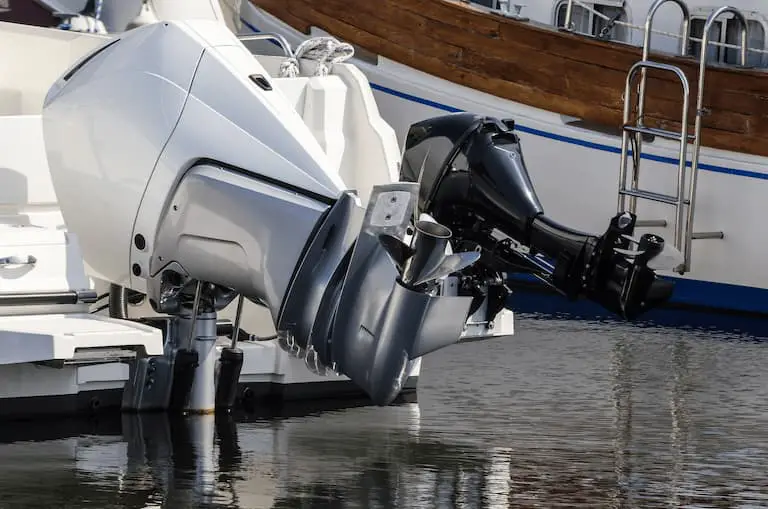
Do All Boat Motors Have Mufflers? (Explained)
Boat motors produce a great deal of noise, which can disturb people on the water and wildlife. Many states have laws requiring boat owners to install mufflers on their vessels’ motors to reduce the noise they make. In some cases, violators may be subject to fines. Not all boat motors have mufflers. Some boat motors…
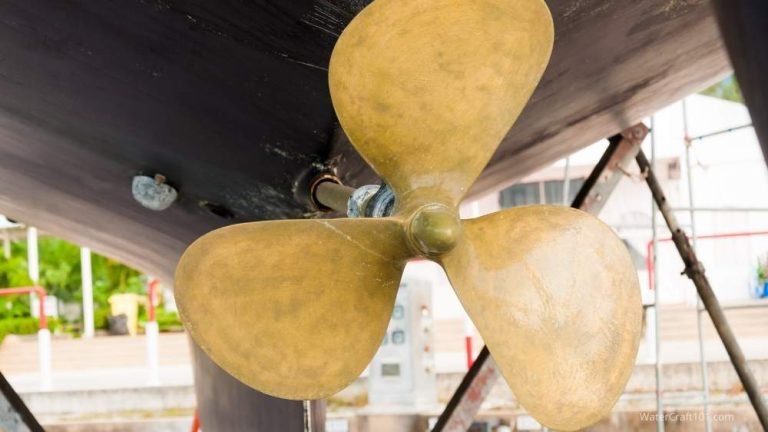
Why Boat Propellers Are Made Out of Brass (Revealed)
Boat propellers were invented in the early 19th century and changed the way boats were constructed and functioned. Before this, boats moved mainly via sails or rowing and wheel mechanisms. Boat propellers revolutionized the industry as they could allow ships to move faster and gave captains more control. Boat propellers are made from brass because…


Motorboat vs. Sailboat Charter: Which is the best for you?
- July 18, 2019
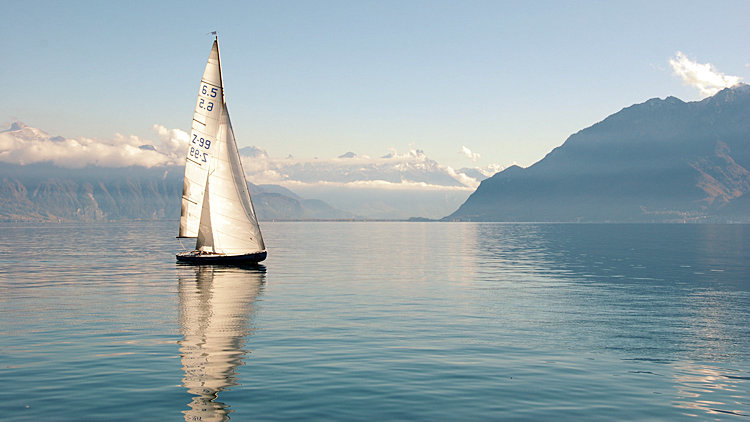
A yachting holiday can be adventurous, relaxing, inspiring, and many other things. If you’re planning a yachting vacation for this summer, one of the first things you will have to decide will be the type of boat you want, if you don’t already own one. You will have to choose between a motor yacht charter and a sailing boat, and your decision will depend on a number of factors. Your destination, the number of people who will be traveling, and the kind of experience you want to have will all help you decide on which kind of boat to head out to sea.
A sailboat will take you on an adventurous, romantic journey where you will connect with the sea and the elements. Unless you opt for a fully crewed charter, you will also learn the basics of sailing and handling the ropes, the sails and the terminology. Motor yachts offer speed, excitement and all kinds of possibilities for onboard entertainment. Sailing trips offer different unique experiences, and you can choose which one is right for you this summer.
Bring the Party With You on a Motor Yacht
Motor boat yachts are descended from sailing yachts but with one big difference. They are powered by engines rather than sails, which makes you independent of weather conditions. Their powerful engines make them very stable, and give you the speed and freedom to chart your own route.
Because of their design, which has a shallower draft, motor yachts can navigate shallow coastal waters. This makes them the ideal craft for island hopping, whether it’s the Caribbean or the Aegean Sea. These roomy craft also have facilities like bars, jacuzzis, and even dance floors and bars swimming pools. There’s plenty of space for parties, fundraisers and larger groups.
Motor yachts generally have larger cabins and more room. Cost is another factor in deciding between a motor yacht or a sailing boat, and motor yacht charters can be very reasonably priced. Keep in mind however that fuel costs will tend to run high.
If speed in getting to your destination is a consideration, motor yachts are the better choice. If however you want to travel the seas powered by the wind, a sailing boat is right for you.
Sailboat Charters Take You Anywhere You Want to Go
A sailboat charter is the perfect getaway, because it is a little floating world of its own. If you’re new to sailing, you’ll be glad to hear that sailboats are also very stable. There are many different types of sailboats, based on their design and size.
Typical charter sailboats will have anywhere from one to six cabins, located on the lower deck. There’s usually also a saloon, which can be a dining room and common area. It can also be used for extra sleeping space at night.
Sailboats generally have fewer people on board than motor yachts, and they can do longer trips. In fact, they can take you to all kinds of exotic destinations, from the Mediterranean to Tahiti and points between. You can even circumnavigate the globe.
Sailboat charters are a great idea for a family vacation. There’s less room on a sailboat than a motor yacht, and more shared spaces. Keep in mind that life onboard in close quarters can produce its own stresses, and chose your travel companions and their cabin allotments carefully.
Different Types of Sailboat Charters
Depending on your sailing experience and the level of comfort you’re looking for on your yachting holiday, several different types of sailing boat charters are available. You can pick a bareboat charter without a crew, or a skippered yacht charter where you get a boat and a skipper, or a fully crewed yacht.
Bareboat charters are suitable if you or a member of your party is a licensed skipper with all the requisite certificates, permits and documents. That’s because you will be sailing on your own, so it’s necessary to have someone who knows what they’re doing and can guide others. The yacht will come fully equipped with a reservoir of fuel, ropes, life jackets and other necessities. There may also be extras like a generator, air-conditioning, coffee machine, ice maker etc.
Bareboat charters are best for sailing in waters which have easy access to anchorage in case of rough weather, like the most of Mediterranean coast along Croatia, Greece, Italy and Spain.
A skippered yacht will give you a boat and an experienced skipper who will steer, help you select the route, and ensure the safety of the boat and all on board. Skippers also typically know a lot about various sailing destinations and can act as informal tourist guides. They may also share tips about sailing. If you’re heading for destinations like the North Sea, the Atlantic and the Caribbean, where the going can be rough at times, it’s best to charter a skippered yacht.
A fully crewed yacht charter comes with a skipper and crew as well as the boat. This is the luxury option, where the crew will not only sail and navigate but also provide your meals and drinks.
Motor boat yachts and sailboats offer unique and different experiences, and both have their supporters. Once you decide which one is right for you, the next step is to plan your route. Bon voyage!
Sign-up for Our Email Newsletter
Find a luxury hotel & book with exclusive perks.

- Luxury Partners

Atlantis Dubai - An iconic entertainment destination comprised of two world-class resorts that bring you extraordinary experiences.

JW Marriott The Rosseau Muskoka Resort & Spa
Villa Lala — Romantic Boutique Hotel in Puerto Vallarta

Cabo Platinum - Cabo San Lucas Luxury Villas, Yachts & Concierge Services

Villa Firenze - Costa Rica Luxury Villa Rental

JUP - Personal Service for Buying and Selling Real Estate in Jupiter, Florida

Polaris Slingshot - A three-wheeled sensation that re-ignites your love for driving

Rancho Valencia Resort & Spa - Rancho Santa Fe, California - One of the West’s most sought-after five star resorts

Tuscan Dream - Immerse Yourself in the Tuscan Villa Vacation Experience

Grand Hotel Portovenere - Cinque Terre - Discover this beautiful region of Italy!

Dude Ranchers Association - An all-inclusive vacation experience like no other

El Encanto, A Belmond Hotel - Santa Barbara, California - Experience timeless Californian glamor.

Grand Hyatt Kauai Resort & Spa - Poipu, Kauai, Hawaii - Beachfront Resort

A.M.A Selections - Luxury Villa Rentals throughout Europe

Culture, Spirituality, and Wellness in Japan's Tochigi Prefecture

Blue Waters Resort & Spa - Antigua - A hidden gem nestled in a private bay on Antigua's northwestern coast with sunset views

Live Aqua Beach Resort Cancun, Mexico - Adults Only, All Inclusive

Argentario Golf & Wellness Resort - Porto Ercole, Tuscany, Italy

Porto Zante Villas & Spa - Zakynthos, Greece - The leading villa resort in Europe

What Is an Open Motorboat? (Here’s What You Should Know)
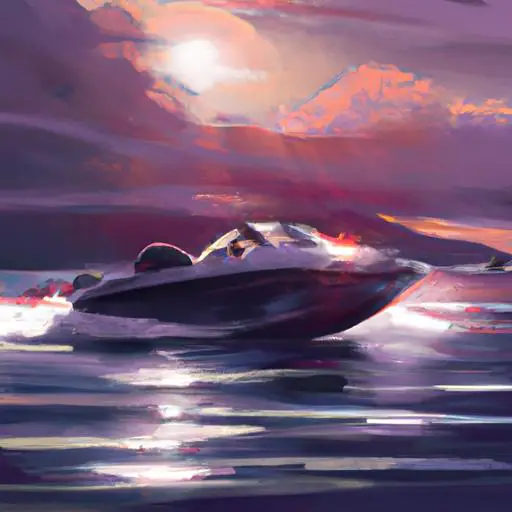
If you’re looking for a new way to explore the open waters, an open motorboat might be the perfect fit.
From the thrill of speed to the peacefulness of a sunset cruise, open motorboats offer an incredibly versatile way to enjoy the water.
In this article, we’ll take a deep dive into the world of open motorboats, from the benefits to the safety considerations, so you can make an informed decision.
Let’s get started!
Table of Contents
Short Answer
An open motorboat is a type of boat that is powered by an engine and has an open deck, usually without a canopy or any other kind of protection from the elements.
This type of boat is typically used for recreational activities such as fishing, skiing, and water sports.
They are usually lightweight, easy to maneuver, and relatively inexpensive to buy and maintain.
What is an Open Motorboat?
An open motorboat is a type of recreational boat with an open deck and an outboard motor for propulsion.
It typically has one or more seats, and is designed for speed and maneuverability.
Open motorboats are popular for leisure activities such as fishing, water sports, and sightseeing.
They are also used for commercial applications such as transportation and rescue services.
Open motorboats are typically made from fiberglass, aluminum, or wood.
They come in a variety of sizes, ranging from small personal boats to larger vessels that can carry up to 10 passengers.
The size of the boat will affect its performance and capabilities.
Smaller boats are typically more maneuverable, while larger boats may have a higher maximum speed.
Open motorboats are powered by outboard motors, which sit on the stern of the boat and are used to propel the vessel forward.
Outboard motors are available in different sizes and power ratings, ranging from small 2-stroke engines to larger 4-stroke engines.
The size of the engine will affect the speed and power of the boat.
Many open motorboats are equipped with features such as GPS navigation, outboard motors, and radios for communication while on the water.
These features can help to make boating safer and more enjoyable.
It is important to be aware of the local laws and regulations governing the use of open motorboats, and to always wear a personal flotation device when boating.
In conclusion, an open motorboat is a type of recreational boat that is powered by an outboard motor and is designed for speed and maneuverability.
They are popular for leisure activities such as fishing, water sports, and sightseeing.
Benefits of an Open Motorboat

Open motorboats offer a number of benefits compared to other types of recreational boats.
Firstly, they are relatively affordable, and can be purchased for prices that are significantly lower than other types of boats.
Additionally, they are extremely versatile, and can be used for a variety of activities, including fishing, water sports, sightseeing, and commercial activities.
Furthermore, they are lightweight and easy to maneuver, which makes them ideal for navigating tight spaces and shallow waters.
Open motorboats are also usually equipped with modern features such as GPS navigation, outboard motors, and radios, which make them even more practical and enjoyable to use.
Finally, they require minimal maintenance, making them a great choice for those who want to enjoy the water without the hassle of dealing with complex repairs.
Types of Open Motorboats
Open motorboats come in a variety of shapes and sizes, offering a range of features and capabilities to suit different needs and preferences.
From more traditional designs that are great for leisurely outings, to high-performance vessels made for speed and maneuverability, there is an open motorboat for every type of boater.
Inflatable boats are the most popular type of open motorboat, as they are lightweight and easy to transport, store, and launch.
They are also affordable and require minimal maintenance.
However, inflatable boats are less durable and have lower maximum horsepower ratings than other types of open motorboats.
Pontoon boats are another popular type of open motorboat.
These vessels are designed with two or three pontoons, which provide stability and increased buoyancy on the water.
They are great for long-distance cruising and can be equipped with amenities such as seating, tables, and grills.
Speedboats are the fastest type of open motorboat and are designed for speed and maneuverability.
They are usually equipped with a powerful outboard motor and are capable of reaching high speeds.
Speedboats are often used for racing and water sports, such as wakeboarding and waterskiing.
Fishing boats are designed with features specifically for anglers.
They are usually equipped with a trolling motor, an anchor, rod holders, and plenty of storage space for tackle and equipment.
Fishing boats also come in a variety of sizes and styles, from small, lightweight vessels to larger, sturdier vessels.
Finally, there are specialized open motorboats designed for specific activities, such as rescue and transportation services.
These vessels are often equipped with features such as GPS navigation, powerful outboard motors, and radios for communication while on the water.
No matter what type of open motorboat you choose, it is important to make sure that it is the right size and has the features you need.
If you are unsure of what type of boat is best for you, it is always a good idea to consult with a knowledgeable boat dealer or experienced boater.
Safety Considerations

When operating an open motorboat, safety should be top of mind for all passengers.
Since open motorboats are designed for speed and maneuverability, they are more likely to encounter hazardous conditions on the water.
It is important to check the weather conditions before setting out, and to wear a life jacket at all times.
In addition, all passengers should be aware of their surroundings, and take necessary precautions when in unfamiliar waters.
It is also important to equip the boat with the necessary safety equipment, such as a fire extinguisher, first aid kit, and emergency signaling device.
Finally, it is important to know the rules and regulations for operating a vessel in the area, as well as the laws for protecting the local marine environment.
By following these safety precautions, open motorboat operators can ensure a safe and enjoyable experience out on the water.
Operating an Open Motorboat
Operating an open motorboat is a fun and rewarding experience for recreational users and commercial operators alike.
For those looking to get the most out of their boat, there are a few key considerations to keep in mind.
First and foremost, it is important to understand the local regulations and safety requirements for operating an open motorboat.
Depending on the area, operators may need to obtain a license or other certification before they are legally allowed to be on the water.
Additionally, it is important to understand the basics of navigation and proper boat operation, including how to read nautical charts, operate navigational systems, and follow safe boating practices.
When operating an open motorboat, it is essential to practice safe boating at all times.
This includes wearing a life jacket, staying aware of your surroundings, and understanding the proper protocol for passing other vessels and navigating in congested areas.
Additionally, it is important to check the weather conditions before heading out, as well as to be aware of any potential hazards or obstacles in the water.
Finally, it is important to remain aware of the legal limits on speed and other regulations that may apply to your area.
Overall, operating an open motorboat can be a fun and rewarding experience.
By understanding the local regulations and safety requirements, as well as following proper boating practices, you can ensure that your time on the water is safe and enjoyable.
Outfitting an Open Motorboat

Outfitting an open motorboat can be an exciting and rewarding experience.
Outfitting the boat with the right equipment will ensure you get the most out of your motorboat and have a successful outing.
Here is what you should consider when outfitting your open motorboat.
The first step in outfitting your open motorboat is selecting an appropriate outboard motor.
Outboard motors come in a variety of sizes and power levels, and you must choose a motor that is sized appropriately for your boat and the type of activity you plan to do.
If your boat is large enough, you may also consider outfitting it with an inboard motor, which can provide more power and greater fuel economy.
Next, you should consider the type of navigation and communication equipment you will need.
Many open motorboats are equipped with a GPS navigation system.
This will allow you to track your location and navigate safely in unfamiliar waters.
Additionally, you should consider a VHF radio for communication with other boats and marinas, and an AIS receiver to identify other vessels in the area.
You should also consider safety equipment such as life jackets, a fire extinguisher, and a first aid kit.
Life jackets are essential for everyone on board and should be worn at all times.
A fire extinguisher should be kept handy in case of an emergency.
A first aid kit should be stocked with bandages, antiseptic ointment, and a few other basic supplies for treating minor injuries.
Finally, you should consider the types of accessories you will need for your open motorboat.
These can include fishing rods, bait, tackle, lines, and other fishing equipment.
You may also want to invest in a tow rope, a fishing net, and some extra fuel.
Other accessories such as a cooler, a waterproof bag, and a waterproof phone case may also be useful.
Outfitting your open motorboat is an important part of the process.
By taking the time to select the right equipment and accessories, you will be able to enjoy your time on the water safely and comfortably.
Local Laws and Regulations
When it comes to open motorboats, its important to understand the local laws and regulations that govern their use.
Every state has its own set of laws and regulations that apply to open motorboats, and its important to be aware of them before going out on the water.
Generally speaking, open motorboats must follow the same rules as other motorized boats, such as staying a certain distance away from other boats, obeying navigational markers, and avoiding restricted areas.
In addition to state laws, open motorboats may also be subject to local regulations, such as speed limits or size restrictions.
Its important to check with your local government to make sure you are in compliance with all applicable rules and regulations.
Some states also require open motorboats to be registered and equipped with safety equipment, such as life jackets, fire extinguishers, and whistles.
In addition, open motorboats must adhere to other safety measures, such as wearing life jackets and avoiding alcohol while operating the vessel.
Its also important to have the necessary knowledge and experience to safely operate the boat.
Taking a boating safety course is a great way to make sure youre up to speed on the latest safety regulations and best practices.
Whether youre out for a leisurely cruise or taking part in a water sport, its important to be aware of the laws and regulations governing the use of open motorboats.
By understanding the rules and following proper safety procedures, you can have a safe and enjoyable experience out on the water.
Final Thoughts
Open motorboats provide a great way to explore the outdoors, whether it’s for leisure activities, commercial applications, or simply sightseeing.
With their speed and maneuverability, they can be used for a variety of purposes.
It is important to consider safety when operating an open motorboat, as well as familiarizing yourself with local laws and regulations.
Taking the time to properly outfit and maintain your open motorboat will further ensure your safety and enjoyment out on the water.
If you’re looking for a way to explore the water, an open motorboat is a great place to start!
James Frami
At the age of 15, he and four other friends from his neighborhood constructed their first boat. He has been sailing for almost 30 years and has a wealth of knowledge that he wants to share with others.
Recent Posts
When Was Banana Boat Song Released? (HISTORICAL INSIGHTS)
The "Banana Boat Song" was released in 1956 by Harry Belafonte. This calypso-style song, also known as "Day-O," became a huge hit and remains popular to this day for its catchy tune and upbeat...
How to Make Banana Boat Smoothie King? (DELICIOUS RECIPE REVEALED)
To make a Banana Boat Smoothie King smoothie at home, start by gathering the ingredients: a ripe banana, peanut butter, chocolate protein powder, almond milk, and ice. Blend the banana, a scoop of...

Please verify you are a human
Access to this page has been denied because we believe you are using automation tools to browse the website.
This may happen as a result of the following:
- Javascript is disabled or blocked by an extension (ad blockers for example)
- Your browser does not support cookies
Please make sure that Javascript and cookies are enabled on your browser and that you are not blocking them from loading.
Reference ID: 703afae0-34f6-11ef-889c-ab4da4f8d335
Powered by PerimeterX , Inc.
Swan Boat Club driver bound over for trial after having 0.18 blood alcohol result

Monroe — A woman who drove her car into a boat club in April, killing two children and injuring 11 others, was bound over for trial Thursday after testimony in her preliminary exam showed she had a blood alcohol level that was twice the legal limit and had told police that she shouldn't be driving.
One of the spectators in the crowded courtroom yelled "yes" when 1st District Court Judge Michael Brown found that prosecutors had provided enough evidence to bind over all charges against Marshella Chidester, 66, of Newport.
Chidester is charged with two counts of second-degree murder, two counts of operating under the influence of alcohol causing death and four counts of operating under the influence of alcohol causing serious injury. She faces up to life in prison if convicted.
The decision came Thursday afternoon after Monroe County Sheriff’s deputy Steven Schmidt testified earlier that Chidester had a blood alcohol level of 0.18. The legal limit in Michigan is 0.08, and the state super drunk definition is 0.17.
Ken Laurain, assistant prosecuting attorney for Monroe County, declined to discuss the judge's decision, while Chidester's attorney, Bill Colovos, said he looked forward to proving her innocence. He said during an earlier arraignment that Chidester drank a single glass of wine and her impairment was caused by seizures.
"When the medical records come out, you'll see about the seizures," Colovos told The Detroit News on Thursday.
After the crash at Swan Boat Club on April 20, Chidester smelled like alcohol and had trouble maintaining her balance, testified Sgt. Michael Bomia, who was the first deputy on the scene. In a field sobriety test, she recited the alphabet correctly but had trouble focusing on the deputy's finger and counting backward from 100, Bomia said.
Chidester, responding to questions from another deputy at the crash site, said she shouldn’t be driving and rated her drunkenness at 7 on a scale of 1 to 10, with 10 being highly drunk. She said she had been drinking wine 30 minutes before the crash and was on medication for seizures.
"I wouldn't want to drive," she told another deputy, Schmidt, after he asked whether she should be driving.
Chidester told Schmidt that she didn’t remember what happened, according to Thursday's testimony.
“I pulled into the parking lot,” she told Schmidt, according to a video played during the hearing. “I thought I was driving up to the boat club. Evidently, I was driving right into the building.”
“You don’t remember what happened?” Schmidt asked.
“You know what, I have these seizures,” she said.
The crash killed 8-year-old Alanah Phillips and her 4-year-old brother, Zayn Phillips. Their mother, Mariah Dodds, and another sibling were among the injured.
Defense lawyer challenges video
Chidester is a former commodore at the boat club, which is located off Swan Creek near Lake Erie. It’s a membership-based organization that hosts holiday parties and other events, and provides docking space for members who own boats, according to its website.
Colovos argued against showing the video of Chidester, saying prosecutors hadn't directly proved she had been read her Miranda rights. The prosecutor indicated the rights had been given, but Colovos said the prosecution needed to produce the officer who read Chidester her rights before the video of her interview could be introduced. The judge let the video be shown after he was assured the Miranda rights had been administered.
During the Thursday hearing, another video showed Chidester getting into her car moments before the crash. The video, taken from a camera across the street from her home, shows her walking unsteadily from her home to her car.
Chidester quickly backed out of her driveway into the road and, while driving backward, swerved onto the shoulder of the road, according to the video. The camera momentarily loses view of her and then showed her driving frontward in the opposite direction toward the boat club, which is 500 feet from her home.
A neighbor had told police earlier that someone had rammed his car, pushing it into a fence, in the moments before the boat club crash. The video showed the collision, and a deputy testified Thursday that Chidester's car was involved in two crashes, the club and the car.
Dead children's mom testifies
Among the injured people who testified during the hearing Thursday was Dodds, the mother of the two children who died.
Dodds and her children were at a party at the boat club for the 3-year-old child of Dodds' friend, according to a Detroit law firm representing Dodds' family in a lawsuit against Chidester and the tavern where she reportedly was before the crash.
She said the only thing she remembered about the crash were the voices of several relatives. The relatives, who weren’t the two children who died, sounded far away, she said.
Her last memory before the accident was a happy one, Dodds said. She walking back to the table where her children were sitting and eating.
“I was laughing,” Dodds said.
Her next memory was waking up in a hospital room, where she remained for four days, she testified. One of her three children who survived was also hospitalized, she said.
Two months after the wreck, her son still needs more rehabilitation before he regains the ability to walk, Dodds said.
Videos show people screaming
During the hearing at 1st District Court in Monroe, Chidester’s attorney objected to the showing of several of the videos, arguing they weren't relevant. He said he had provided the county prosecutor's office with medical records about her condition.
Other videos played during the hearing showed the aftermath of crash, with people screaming while others scooped up children and fled the scene.
One video from the boat club showed a car traveling at a high rate of speed through the club's parking lot and then veering into the building at around 3 p.m. on April 20.
Another video showed people trying to clear debris and get to people trapped by the car against a wall. A child could be seen being pulled from behind a counter near where the car crashed.
"It was a chaotic scene," Bomia said.
In another scene, people could be seen pulling a woman from the floor, bloodied by the crash.
In a body-worn camera from a Monroe County sheriff's deputy, Chidester is shown sitting in a chair as the deputy arrives at the chaotic scene. Chidester was taken outside to the police car, where she answered questions.
Colovos said earlier that Chidester had blacked out from a seizure behind the wheel and didn’t remember the crash or anything leading up to it.
More: Aunt of siblings killed at party: 'We were supposed to be planning a birthday ... not a funeral'
Chidester suffers from neuropathy and has epileptic-like seizures in her legs, Colovos said earlier. She was hospitalized last fall after being treated for epileptic-type seizures in her legs, he said.
Two Metro Detroit medical experts told The Detroit News in May that the medical condition attributed to the woman may affect one's ability to drive, but the condition is not known for causing a loss of consciousness.
More: Medical experts weigh in on conditions attributed to driver in Swan Boat Club crash
Prosecutors said during an arraignment in April that Chidester drunkenly crashed her SUV into a boat club that was hosting a child's birthday party. They said she has had substance abuse issues. But Colovos said Chidester had no traffic tickets or police record.
(313) 223-4186
@prima_donnelly
- Election 2024
- Entertainment
- Newsletters
- Photography
- Personal Finance
- AP Investigations
- AP Buyline Personal Finance
- AP Buyline Shopping
- Press Releases
- Israel-Hamas War
- Russia-Ukraine War
- Global elections
- Asia Pacific
- Latin America
- Middle East
- Election Results
- Delegate Tracker
- AP & Elections
- Auto Racing
- 2024 Paris Olympic Games
- Movie reviews
- Book reviews
- Financial Markets
- Business Highlights
- Financial wellness
- Artificial Intelligence
- Social Media
Philippines demands China return rifles and pay for boat damage after hostilities in disputed sea
The Philippine military chief demanded Wednesday that China return rifles and other equipment seized by the Chinese coast guard in a disputed shoal and pay for damage in an assault he likened to an act of piracy in the South China Sea.
In this handout photo provided by Armed Forces of the Philippines, Chinese Coast Guard hold knives and machetes as they approach Philippine troops on a resupply mission in the Second Thomas Shoal at the disputed South China Sea on June 17, 2024. The Philippine military chief demanded Wednesday that China return several rifles and equipment seized by the Chinese coast guard in a disputed shoal and pay for damage in an assault he likened to an act of piracy in the South China Sea. (Armed Forces of the Philippines via AP)
- Copy Link copied
This handout photo provided by Armed Forces of the Philippines shows the windshield, communications and navigational equipment on a Philippine Navy Rigid Hull Inflatable Boat allegedly destroyed by the Chinese Coast Guard to prevent Philippine troops on a resupply mission in the Second Thomas Shoal at the disputed South China Sea on June 17, 2024. The Philippine military chief demanded Wednesday that China return several rifles and equipment seized by the Chinese coast guard in a disputed shoal and pay for damage in an assault he likened to an act of piracy in the South China Sea. (Armed Forces of the Philippines via AP)
In this handout photo provided by Armed Forces of the Philippines, Chinese Coast Guards hold an axe as they approach Philippine troops on a resupply mission in the Second Thomas Shoal at the disputed South China Sea on June 17, 2024. The Philippine military chief demanded Wednesday that China return several rifles and equipment seized by the Chinese coast guard in a disputed shoal and pay for damage in an assault he likened to an act of piracy in the South China Sea. (Armed Forces of the Philippines via AP)
This handout photo provided by Armed Forces of the Philippines shows communications and navigational equipment on a Philippine Navy Rigid Hull Inflatable Boat, allegedly destroyed by the Chinese Coast Guard to prevent Philippine troops on a resupply mission in the Second Thomas Shoal, at the disputed South China Sea on June 17, 2024. The Philippine military chief demanded Wednesday that China return several rifles and equipment seized by the Chinese coast guard in a disputed shoal and pay for damage in an assault he likened to an act of piracy in the South China Sea. (Armed Forces of the Philippines via AP)
This handout photo provided by Armed Forces of the Philippines shows a Philippine Navy Rigid Hull Inflatable Boat, allegedly destroyed by the Chinese Coast Guard to prevent Philippine troops on a resupply mission in the Second Thomas Shoal, at the disputed South China Sea on June 17, 2024. The Philippine military chief demanded Wednesday that China return several rifles and equipment seized by the Chinese coast guard in a disputed shoal and pay for damage in an assault he likened to an act of piracy in the South China Sea. (Armed Forces of the Philippines via AP)
FILE - In this handout photo provided by the Philippine Coast Guard, a Chinese coast guard ship uses water canons on a Philippine Coast Guard ship near the Philippine-occupied Second Thomas Shoal, South China Sea as they blocked it’s path during a re-supply mission on Aug. 5, 2023. The Philippine military chief demanded Wednesday that China returns several rifles and equipment seized by the Chinese coast guard in a disputed shoal and pay for damage it caused to two navy rubber boats in an assault he likened to an act of piracy in the South China Sea.. (Philippine Coast Guard via AP)
FILE - A dilapidated but still active Philippine Navy ship BRP Sierra Madre sits at the Second Thomas Shoal, locally known as Ayungin Shoal, at the disputed South China Sea on Aug. 22, 2023. The United States renewed a warning Tuesday, June 18, 2024 that it’s obligated to defend its close treaty ally a day after Filipino navy personnel were injured and their supply boats damaged in one of the most serious confrontations between the Philippines and China in a disputed shoal in the South China Sea, officials said. (AP Photo/Aaron Favila, File)
MANILA, Philippines (AP) — The Philippine military chief demanded Wednesday that China return several rifles and equipment seized by the Chinese coast guard in a disputed shoal and pay for damages in an assault he likened to an act of piracy in the South China Sea.
Chinese personnel on board more than eight motorboats repeatedly rammed then boarded the two Philippine navy inflatable boats Monday to prevent Filipino navy personnel from transferring food and other supplies including firearms to a Philippine territorial outpost in Second Thomas Shoal, which is also claimed by Beijing, according to Philippine officials.
After a scuffle and repeated collisions, the Chinese seized the boats and damaged them with machetes, knives and hammers. They also seized eight M4 rifles, which were packed in cases, navigation equipment and other supplies and wounded a number of Filipino navy personnel, including one who lost his right thumb, two Philippine security officials told The Associated on Tuesday.
The two officials spoke on condition of anonymity because of a lack of authority to discuss the sensitive conflict publicly.
Video and photographs issued by the Philippine military Wednesday night show the chaotic faceoff at the shoal, with Chinese personnel onboard boats brandishing knives, axe and sticks while surrounding two Philippine navy supply boats beside Manila’s ship outpost. Sirens blare constantly as both sides yell at each other and the Chinese smash the Philippine navy boat with a pole and grab what appears to be a bag with a stick.
Pictures show a damaged Philippine navy boat with its side floaters slashed and deflated and another boat with its windshields and navigational screens shattered. A man displays a damaged cellphone.
“We are demanding that the Chinese return our rifles and our equipment and we’re also demanding that they pay for the damage they caused,” Gen. Romeo Brawner Jr., head of the Philippine armed forces, said in a news conference in western Palawan province, where he pinned a medal on the wounded navy officer.
“They boarded our boats illegally and seized our equipment,” Brawner said. “They’re now like pirates with this kind of actions.”
Armed with long knives and machetes, the Chinese coast guard personnel tried to beat the unarmed Filipinos, who resisted with their bare hands by parrying the blows and pushing back the Chinese, Brawner said. “Our objective is also to prevent war.”
Some of the Chinese pointed their knives at the Filipino navy personnel, he said.
China blamed the Philippines for the confrontation, saying the Filipino personnel “trespassed” into the shoal in defiance of its warnings.
“This is the direct cause of the incident,” Foreign Ministry spokesperson Lin Jian said in Beijing. “The Chinese coast guard at the scene has taken professional law-enforcement measures with restraint aimed at stopping the illegal supply mission by the Philippine vessels and no direct measures were taken against the Philippine personnel.”
The United States renewed a warning Tuesday that it is obligated to defend the Philippines, a treaty ally.
Second Thomas Shoal, part of the disputed Spratly Islands, has been occupied by a small Philippine navy contingent aboard a grounded warship that has been closely monitored by China’s coast guard and navy in a yearslong territorial standoff. China claims the South China Sea virtually in its entirety.
There is fear that disputes in the South China Sea, long regarded as an Asian flashpoint, could escalate and pit the United States and China in a larger conflict. Aside from China and the Philippines, Vietnam, Malaysia, Brunei and Taiwan have conflicting territorial claims in the busy waterway.
Since last year, hostilities between China and the Philippines have escalated in the disputed waters, particularly in Second Thomas Shoal , which is less than 200 nautical miles (370 kilometers) from the Philippine coast and where the BRP Sierra Madre, now encrusted with rust, was deliberately grounded in 1999 to create a territorial outpost. The ship remains an actively commissioned military vessel, meaning an attack on it could be considered by the Philippines as an act of war.
'Only pirates do this,' a general said after China's Coast Guard, armed with bladed weapons, clashed with Philippine boats in the South China Sea
- A Philippine general called China's coast guard pirates after a violent confrontation.
- China's Coast Guard disrupted a Philippine resupply mission at Second Thomas Shoal.
- Experts say it's not piracy, but it's a troubling escalation all the same.

The Chief of Staff of the Armed Forces of the Philippines accused China of behaving like pirates after members of China's coast guard aggressively clashed with Philippine vessels running a resupply mission on Monday, wielding bladed weapons.
"Only pirates do this," General Romeo Brawner Jr. said in a social media post regarding the recent actions of the Chinese coast guard. "Only pirates board, steal, and destroy ships, equipment, and belongings."
Beijing has blamed the Philippines for the incident, with a foreign ministry spokesperson saying Thursday that "the Philippine side has been calling white black and falsely accusing China."
Footage of the encounter showed China's Coast Guard fleet surrounding Philippine vessels in the South China Sea that were in the process of conducting a resupply and rotation mission. The Chinese vessels closed in and tensions flared. The incident marked an escalation amid months of confrontations in the area.
Members of the Coast Guard are seen in the videos wielding blades and removing objects from the Philippine vessel.
This is how barbaric the Chinese Coast Guard is in the recent RoRe mission of the Armed Forces of the Philippines. These videos show how blatantly they use physical attacks and violence to prevent our soldiers from completing the legitimate and humanitarian resupply mission to… pic.twitter.com/7vzFDem1DE — Jay Tarriela (@jaytaryela) June 19, 2024
The Philippine general added that the crew members aboard the ambushed vessels were outnumbered and "fought with bare hands" against the Chinese coast guard personnel.
Related stories
Though the Chinese coast guard behavior documented by the Philippines is aggressive, it's not piracy, an expert explained, but it's still a serious problem.
The Chinese coast guard might have used pirate-like tactics, but it's not legally piracy. The incident wasn't on the high seas beyond a country's jurisdiction, and as Harrison Prétat, deputy director of the Center for Strategic and International Studies' Asia Maritime Transparency Initiative, told Business Insider, it wasn't for monetary gain.
The Chinese Coast Guard is "trying to prevent the Philippines from resupplying the BRP Sierra Madre, a ship grounded on Second Thomas Shoal since 1999 where the Philippines maintains a garrison of marines," Prétat explained.
He added that the Permanent Court of Arbitration declared in 2016 that Second Thomas Shoal was a part of the Philippines' exclusive economic zone. Therefore, the Philippines should be able to access Second Thomas and even build artificial structures there in accordance with the UN Convention on the Law of the Sea, to which China is a signatory.
Although the country is a signatory, "China rejects the 2016 ruling and is attempting to enforce its control over maritime activity within its nine-dash line claim," Prétat said. The nine-dash line is a map marking designating China's sweeping and controversial claims to the South China Sea.
This isn't the first time China's coast guard has acted aggressively toward the Philippines at sea, especially over parts of the hotly contested Spratley Islands. In recent months, Chinese ships have also fired water canons at Philippine vessels and even rammed them. Equipment has been damaged, and crew members have been injured. But this week's incident was notable, reaching a new level.
Per other reporting on the incident, Brawner said that the Chinese guardsmen "took guns and other equipment, destroyed our equipment onboard, including the motors. They punctured our rigid-hulled inflatable boats." One of the Filipino crewmembers even lost his thumb in the incident.
"This latest incident is a significant escalation from recent tensions, which previously involved water cannons targeting Philippine civilian boats—this time, the inflatable boat that was boarded and destroyed by Chinese personnel was a Philippine Navy vessel," Prétat said. That raises the stakes.
The maritime expert noted that the attack "could trigger US obligations under the Mutual Defense Treaty." Prétat said it could raise the risk of a conflict between the US and China. Manila does not, however, plan to invoke the treaty . It's a means to prevent further escalation, but the Philippines is demanding China return seized equipment and pay for damages.
US ambassador to the Philippines MaryKay Carlson said this week in a post on X that the US "condemns the PRC's aggressive, dangerous maneuvers," referring to China by the acronym for People's Republic of China.
Watch: Pirate historian rates 8 pirate battles in movies and television
- Main content

IMAGES
VIDEO
COMMENTS
Convertible: A boat with a flying bridge built atop the cabin, and an open cockpit aft. Cuddy Cabin: A powerboat with a relatively small cabin on its bow section. Deck Boat: A motorboat with a flat, open deck plan and without any below-decks accommodations. To create more forward deck space, most deck boats have a rather boxy shape, instead of ...
Comparing inboard vs. outboard boat motor options is an important decision for any prospective boat buyer. Outboards and inboards (sterndrive or I/O) both have pros and cons, and you'll want to look at the differences in maintenance costs. Outboard engines typically deliver better fuel economy & are easier to service.
Cuddy cabin boats have a small cabin for storage or a small seating area. They may accommodate a berth and or head. They are usually about 22-30 feet in length. Deck Boat. Deck boats have a wide beam and feature a V-shaped hull which offers more performance than a pontoon boat. Featuring an open deck with plenty of seating for parties or family.
A motorboat with an outboard motor. A motorboat, speedboat or powerboat is a boat that is exclusively powered by an engine.. Some motorboats are fitted with inboard engines, others have an outboard motor installed on the rear, containing the internal combustion engine, the gearbox and the propeller in one portable unit. An inboard-outboard contains a hybrid of an inboard and an outboard, where ...
Boat length: Typically 3.5m - 10m but can be bigger: Typically 7.5m - 24m. RIB or Hard Boat: Either. Usually a hard boat typically GRP, but can be timber, steel or aluminium). Galley: Not usually, Yes there will be somewhere where you can store food and prepare basic meals, this will usually include a kettle, a fridge, hob(s) and a sink.
Sailboats require a more hands-on approach, which many people prefer. Yet, powerboats have less maintenance and more speed. Which kind of boat you choose depends entirely on what kind of experience you want to have. Powerboats are easier to operate, and they require a little experience. But, they are costly to keep running and you're reliant ...
Most sailboats tap out at 7 knots, but power boats typically travel at speeds of around 15 to 20 knots on a calm day. Space. Powerboats have more space—more deck space and more interior space. There are also more amenities in a powerboat including more cabins, stand-up galleys, etc. Convenience.
Cabin Cruiser: Generally, any larger motorboat that provides sleeping accommodations within its structure. This generic term can be used to describe motoryachts, expresses, and a number of different designs. Center Console: A powerboat with its console and helm located in a central location on deck.
Pros and cons of motorboats. Motorboats are powered by a boat engine. They are much easier to operate than sailboats. All you need is a vessel licence and a good navigation system. In addition, motorboats are fast, reliable and stable on water. They offer plenty of deck space as there is no sail and rig to occupy most of the top area of the boat.
As the name of each type of boat implies, the biggest difference between a motorboat rental and a sailboat rental is the source of power. Sailboat rentals are generally powered by a system of sails, which can come in various shapes and sizes. Motorboat rentals come equipped with a wide range of different inboard and outboard motors.
The main difference between an inboard and an outboard engine is their placement in the boat. An inboard is hidden within the boat and an outboard is 100% visible. The boat on the left has an inboard or sterndrive motor and the boat on the right has an outboard motor. When you initially purchase your boat you will have to select and purchase an ...
Generally, sailboats tend to be better liveaboards, since they are more spacious, cheaper to buy, cheaper to operate, and provide better peace of mind than powerboats. Sailboat hulls are also among the most stable designs available. Powerboats are faster, but typically also smaller, and are a lot more expensive to run.
Motor yacht: An upscale type of boat, a motor yacht includes up to two engines, typically diesel engines. These boats turn heads and make people yearn for the good life on the sea. Cabin cruiser: An enclosed type of boat, cabin cruisers are very luxurious as well. The boat has a galley and runs on a generator so it can offer air conditioning.
Read More 12 Reasons a Speed Boat Motor Loses Power. Power Boating. 5 Signs Of A Bad Impeller In Outboard Boat Motors (Revealed!) By Bryan Mullennix. Despite being a tiny object, an impeller is one of the essential parts of a motorboat engine, and it plays a big part in pumping raw water from outside a motorboat to cool the engine. But it seems ...
I go through all the pluses and minus of sail and power boats, compare them and give you my opinion as to which is betterhttps://www.patreon.com/sailingdoodl...
The benefits of this are countless. However, an outboard motor mostly enables you to navigate shallower waters better and park your boat up neatly. Although there is one thing to bear in mind: despite having a superior power to weight ratio than inboards, outboards lack the total torque to drive big, beefy vessels.
Motor yachts generally have larger cabins and more room. Cost is another factor in deciding between a motor yacht or a sailing boat, and motor yacht charters can be very reasonably priced. Keep in mind however that fuel costs will tend to run high. If speed in getting to your destination is a consideration, motor yachts are the better choice.
n the right-o. -way by any rule of this section.(b) Crossing. When aircraft, or an aircraft and a vessel, are on crossing courses, the aircraft or v. ssel to the other's righ. has the right-of-way.(c) Approaching head-on. When aircraft, or an aircraft and a vessel, are approaching head-on, or nearly so, each shall a. ter its course.
Best uses: dive boat or work boat. Dinghy— These are small boats, sometimes less than 10 feet long. They can be powered "manually," by oars or even by a small outboard motor. Best uses: transportation to larger boat at anchor or as a "first boat" for children. Inflatable— Inflatable boats are made of coated fabric.
An open motorboat is a type of boat that is powered by an engine and has an open deck, usually without a canopy or any other kind of protection from the elements. This type of boat is typically used for recreational activities such as fishing, skiing, and water sports. They are usually lightweight, easy to maneuver, and relatively inexpensive ...
Cost. You can buy a well-kept used sailboat is between $15,000- $40,000 and a new boat you have buy for $80,000 to $150,000 depending on the type of the sailboat. You must also account for regular maintenance, insurance, docking fees, and more. The average cost of a new motorsailer is around $500K.
Put simply, YachtWorld tends to classify vessels over 35 feet in length as yachts, particularly if they exceed 8.5 feet in width and cannot be towed by a car or truck without special permits. But it can get a bit more involved than that, so let's take a deeper look. Above: There is no doubt that the 361-foot superyacht KAOS by OceanCo is a ...
Outboard engines come in a wide range of HP ratings and mount to the transom of a boat outside of the boat's hull. These engines are found on a variety of boats from small runabouts to dual motor center console fishing boats. An outboard engine both powers and steers the boat using a tiller on smaller engines or the steering system on larger boats to turn the entire motor and change the ...
Sailboat vs Motorboat Safety. Sailboat: Motorboat: Percentage of deaths: Unknown, but under 7%: 50% : Boats on the water: ... making it more likely that motor boat owners will end up in dangerous situations without the skill to get out of themAlcohol useMay be less likely to use alcohol because of the concentration and effort required to ...
One video from the boat club showed a car traveling at a high rate of speed through the club's parking lot and then veering into the building at around 3 p.m. on April 20.
The driver accused of killing two young siblings in Newport's Swan Boat Club tragedy will be back in Monroe's district court on Thursday for a hearing that will decide whether the case against ...
Use this addendum when applying to test or demonstrate a motor vehicle equipped with autonomous vehicle technology on public highways in New York State. DTF-802: Statement of Transaction - Sale or Gift of Motor Vehicle, Trailer, All-Terrain Vehicle (ATV), Vessel (Boat), or Snowmobile (at NY State Department of Tax & Finance)
2 of 7 | . This handout photo provided by Armed Forces of the Philippines shows the windshield, communications and navigational equipment on a Philippine Navy Rigid Hull Inflatable Boat allegedly destroyed by the Chinese Coast Guard to prevent Philippine troops on a resupply mission in the Second Thomas Shoal at the disputed South China Sea on June 17, 2024.
'Only pirates do this,' a general said after China's Coast Guard, armed with bladed weapons, clashed with Philippine boats in the South China Sea Ella Sherman 2024-06-21T15:59:32Z